Richard Horvath
2022 Exhibition Catalogue
2024 Exhibition Catalogue
A process worker in a muffler plant, a sailor on a ship plying the North Sea, a maintenance man on a N.A.T.O. base in Germany, a bartender and a worker in a darkroom at a screen printing studio were among the jobs I worked at during my late ‘teens and early twenties, however, it was the latter job that interested me the most and confirmed a love for the printing process. My early body of work included graphic art such as band posters, typified by a crude technique and a raw colour palette that encapsulated the Punk ethos and a selection of this work was acquired, much to my surprise, by the Print and Drawing collection at The National Gallery of Australia. After seeing a friend using 3D modelling software on a computer I resolved to learn this technology which lead to lecturing at R.M.I.T. university and repurposing the Punk style of graphic art I used. In 2010 I started the Re-Imaginings Project which had the broad agenda of reimagining, through the use of 3D computer graphics, some of the compelling visual ideas of the past and present which drives our culture.

Outer Limits Print on metal. Edition of 5 - 60 x 90cm - $3,500 A regular teenage weekly viewing pleasure was the science fiction television series, The Outer Limits. Inevitably, a monster or a transformed human who was typically the consequence of a scientific experiment gone wrong would be the highlight of each episode and I’d eagerly await whatever weirdness the show’s creators came up with to disturb the audience. Occasionally the Outer Limits would resort to outsized or distorted human heads as a creative solution for showing the results of an ethically dubious experiment. Consequently I subjected a generic 3D model male head to various deformations and finding that I quite liked all the results, the idea of a strange sculpture park on a desolate hillock allowed me to include all of them. The ‘curator’ figure wears a lab coat— an Outer Limits prop that serves as shorthand for a scientist.

Spaghetti Western Print on metal. Edition of 5 - 60 x 90cm - $3,500 After viewing some 1960s Spaghetti Westerns my thoughts turned to memories of the Almeria region of Spain which I had visited because some of my favourite westerns had been filmed there. It’s a surprisingly raw desert landscape and impoverished part of Europe. It was immediately clear the film-makers had little to do to make it a convincing Wild West; for example, a local bar I walked into caused heads to turn the way it happens in the saloon scene out of a cowboy film. The intended focus of this artwork is the landscape with its yuccas, prickly pear, stony ground and the goat. The two men serve no narrative apart from appearing native this soil.

Hellbound Print on metal. Edition of 5 - 60 x 90cm - $3,500 I’ve been a longtime fan of film noir and Hellbound, a 1957 crime movie, delivers many of the tropes of the genre, including a femme fatale gangster moll who signifies her sexual availability by slipping off her high heeled shoes. The doomed central character perfectly reflects with the existential worldview of film noir and when he picks up the shoe, his fate is sealed. In the background there is a sinister looking man wearing a dark suit and sunglasses called Daddy and the movie introduces him enjoying a strip show while dealing narcotics. A strung out junkie begs for a hit, imploring him with “please Daddy” while the implacable Daddy angrily responds with “I’m watching the show,” which is ironic because Daddy is blind. I had some trouble getting the woman’s skirt to fall naturally. Instead of manipulating the cloth physics to correct it, I let stay it because it doesn’t harm the erotic undertone of the interaction. Film noir generally favours grungy settings but Hellbound begins with a meeting set in a drug kingpin’s upmarket home. I used A.I. to generate some of the furnishings, notably the artworks.

Nautilus Print on metal. Edition of 5 - 60 x 90cm - $3,500 Watching the 1961 science fiction adventure film, Mysterious Island, I was surprised by the unexpected appearance in the third act by Captain Nemo in his submarine, the Nautilus. Equally surprising was the boat’s art deco design, both externally and internally; of particular note, was the improbable presence of a pipe organ. I researched the original drawings of the Nautilus illustrating Jules Verne’s 20,000 Leagues Under the Sea. I was startled by the double height victorian era mansion style of architecture which included an aquarium, sumptuous library, oil paintings and a decorative suit of armour. For a further comparison, I watched the 1997 movie made of Verne’s book and the Nautilus accommodations were far more rational, albeit quite luxurious. My version follows some semblance of logic while paying homage to the original concept; the difference is that it’s relatively modestly proportioned and decorated, the bare metal of the hull being a reminder we’re looking at a functional object. Nemo, who is studying plans of his creation could pass for a middle-aged home handyman sort of guy.

Love Song Print on metal. Edition of 5 - 60 x 90cm - $3,500 I’ve long been intrigued by the stillness of Giorgio de Chirico metaphysical paintings. The only problem of interpreting his work is the relative absence of close-up human figures; a prerequisite for this series of digital prints. One exception is a painting De Chirico made because of nostalgia for his childhood, The Child’s Brain, which portrayed his father standing undressed in front of a table with a large yellow book. I couldn’t help mating it with one of my favourite De Chirico paintings; Love Song, with its classic sculpture of a head and a red rubber glove mounted on a plaque. Interestingly, the same arched building, seen from the same perspective, appears in both paintings. The column on the left side is a disconcerting pictorial element from The Child’s Brain and even though I had trouble reconciling its compositional presence, I decided to use it to keep it as a visual full stop.

Fate Print on metal. Edition of 5 - 60 x 90cm - $3,500 Kathe Kollwotz’ alarming 1910 etching, Tod und Frau, depicts a very determined skeleton gripping a woman in a wrestling style hold while an equally resolute toddler fights to tear her from its grasp. It’s a powerful artwork I kept looking at even though I felt it was too dark to work with. I decided on an ambiguous interpretation where death sneaks up and caresses his next victim while the child looks on nonplussed. The blurred greenish tinted background suggests the liminal space of an unpleasant dream.

Sad Spider Print on metal. Edition of 5 90 x 60cm $3,500 Odilon Redon’s masterfully drawn The Crying Spider is a deep dive into the human psyche that evokes a response that ranges from sympathy to horror.Redon’s drawing is minimal in detail and I had no plan about what I wanted to do with this image when I started this piece—apart from meeting the challenge of shaping a moderately convincing spider with a man’s head in 3D modelling software. Placing him on a leash held by a young woman was a surreal joke but it could also serve as a symbol of controlling dark primal emotions. I decided the spider should have minimal expression—it simply exists although the concept of an insect who feels is intriguing. The woman wears a mildly thoughtful yet unemotional expression; so the relationship between them is ambiguous

Big Eyes Print on metal. Edition of 5 90 x 60cm $3,500 Big Eyes is a comment on how kitsch appropriates subjects and aesthetics from serious fine art. Classic French kitsch has a particularly interesting caste of characters; the harlequin, clown, hobo and street urchin. It would have required Googling in French to find a decent variety of these examples. Nevertheless I found an interesting 1960s or 1970s painting featuring a cheeky street urchin relieving himself on the bank of the River Seine. Dressed striped skivvy and flared jeans, he complicitly glances over his shoulder at the viewer. A crudely rendered bridge and the Eiffel Tower in the distance makes the setting unmistakable. I lost interest in developing details and settled on a simple yet dynamic composition that reveals little to the viewer. I liked the tension between the big-eyed kid on the precarious path which provides minimal protection from the swollen waters with the overbearing urban architecture of the bridge in the background.

Hypnosis Print on metal. Edition of 5 - 60 x 90cm - $3,500 Sascha Schneider’s disturbing 1904 etching, Hypnosis, exudes themes of domination and submission with a dark, primal energy. The depiction of animal mesmerism and hypnosis in the early years of research presented these phenomena in mysterious occult terms. It’s the triumph of scientific rationalism over the folkloric which encouraged me into this exploration; how rationalism has sapped belief and offers banal reassuring explanations instead. The addition of the forbidding rock face background was one of these regular intuitive decisions which make sense much later; fittingly trusting the subconscious to make the right call.

Exile Print on metal. Edition of 5 - 60 x 90cm - $3,500 Symbolist artist Max Klinger’s take on the expulsion of Adam and Eve from the Garden of Eden is radically different from the miserable and contrite couple portrayed in classic christian iconography. Gone is the moral lesson of obedience to God; instead, an angry Adam strides purposefully across a bleak landscape carrying Eve—suggesting that they intend to enjoy future guilt free nooky. In the background an angel in a bouncer pose stands guard at the entrance to the Garden, a lush mount with a couple of large upright boulders serving as a gate. The interpretation I’ve made dispenses with some detail; the Garden of Eden is merely sketched in and it looks pretty underwhelming; it seems like God underdelivered and the exiled couple could find nicer accommodation elsewhere. Eve looks content and Adam looks resolute about negotiating the wilderness.

Cotton Mather Print on metal. Edition of 5 - 60 x 90cm - $3,500 Cotton Mather was a colonial American puritan clergyman who is mostly remembered for his professed expertise in witchcraft and acting for prosecutors in the Salem witch trials. Equally strange was his assertion that a dinosaur skull which had been discovered was evidence of the existence of Nephilim, a race of giants mentioned in the Bible. During the conceptual development of this piece I juggled with setting this scene in a candle-lit interior with the giant skull conspicuously placed on a table or alternatively locating it outdoors under a starry night. The former approach would have presented interesting lighting possibilities but the philosophic ramifications of the latter, that is, the strangeness of the world reflected in nature under an infinity of stars, would be more conceptually satisfying. Although Mather was a product of his times, I favoured a somewhat unkindly portrayal of the man, dressed in wig and ruffed shirt, stiffly gazing at the mysterious object and not liking what he sees and wondering how it fits in the bible.

Jane Doe Print on metal. Edition of 5 - 60 x 90cm - $3,500 The case of the Anson County Jane Doe has long intrigued missing persons investigators but it was the haunting image of a woman captured by a wildlife camera that gave the case a particularly strange and melancholic aura. The late night photo revealed a barefooted young woman clad in black bra and wet white tights walking with the aid of a pole. She was photographed again hours later returning from the direction she had taken earlier; so she was clearly disoriented. Being lost and alone at night in a forest must be a terrifying experience which I have tried to emphasise by the inky pools of darkness and the unfriendly patches of spiny grasses and the thicket of dead branches.

Lost Hussar Print on metal. Edition of 5 90 x 60cm $3,500 This was originally intended as an exploration of Casper David Friedrich’s The Lost Hussar. Friedrich depicted a French soldier about to stray into a dense forest, and the political metaphor, the defeat of Napoleon’s army a few years earlier, intrigued me. The artwork was stuck until I started leafing through a book of the paintings of contemporary German artist Georg Baselitz. The painter went through a period of hanging his pictures upside down and as an experiment I placed the soldier I had made upside down in the landscape I had started to develop. This decision violated loose rules I had set about this project that patently unrealistic choices should be avoided. The crazy about-face not only rescued a moribund artwork, it presented interesting possibilities for future works

Ghost in the Lantern Print on metal. Edition of 5 90 x 60cm $3,500 The Japanese have been wonderfully inventive in their visual portrayal of ghosts; one of my favourites being chochin-obake, the Ghost in the Paper Lantern, particularly the woodcut print by Katshushika Hokusai. My lantern ghost went somewhat awry because I was experimenting for the first time with the hair particle function in my software and I had yet to figure how to ‘groom’ it, but I thought the disheveled hair worked just fine, looking suitably creepy. Many approaches to the lantern ghost exist but I liked the idea of the ghost coming for a besuited salary man stricken with angst in front of a bush with spear like leaves. I have generally avoided portrait oriented compositions but in this case it was perfect for representing the forces exerted by the gaping maw of the lantern and the downward pointing leaves pressing the victim against the bottom edge of the frame

Aroused Atmospheric Skull with a Grand Piano Print on metal. Edition of 5 - 60 x 90cm - $3,500 Only Salvador Dali could conceive such an outlandish idea as an atmospheric skull sodomising a grand piano. How does a skull become atmospheric and why does it feel driven to have sex with grand piano? Moreover, the skull is performing this act with a ghastly elongated tongue. Dali painted this weird vision taking place on a rocky beach with two distant characters sitting on a stone wall showing their indifference by turning their backs to the action. My interest in the art work grew during an online discussion which resulted in jokes such as, “people in my neighbourhood don’t particularly care for atmospheric skulls because they’re bad for real estate values.” Consequently the first concept for this reimagining was to locate the offending act in a familiar urban environment. I went with an environment that has a lunar landscape feel as a better choice for giving this strange surreal vision its full due. I felt the most interesting framing was to move Dali’s distant couple to the foreground with the nearby skull, in its erotic passion, driving the piano into the earth. The women witnessing the event don’t demonstrate any sense of alarm, only annoyance that the pesky skull insists on indulging its sexual appetite publicly in front of them; the sort of response a dog humping a leg elicits.

Charlotte Corday Print on metal. Edition of 5 - 60 x 90cm - $3,500 The interest in this subject stemmed from a search for information about the cruel and despotic Roman emperor, Heliogabalus that led to Antonin Artaud, the French theatre director, actor and writer who had written a book about him.My research into this man piqued my interest in his theatrical portrayal of the French revolutionary, Jean-Paul Marat. Hitherto, the only depiction I had been aware of was Jacques-Louis David’s famous 1793 painting, The Death of Marat, but more significantly I didn’t know that Marat’s assassin was a woman, Charlotte Corday. As a consequence of hiding from the law in the Parisian sewers, Marat suffered from a skin condition which required substantial periods of immersion in a liquid that offered relief, hence the bathtub became his de facto office which made him an easy target for assassination. I was particularly intrigued by the strange looking bathtub featured in a photo of the Artaud play; it reminded me of an oversized metal boot. I couldn’t resist inserting a punk looking Charlotte wearing a leather jacket and frayed trousers in an otherwise 19th century scene.

Black Metal Print on metal. Edition of 5 - 60 x 90cm - $3,500 Black Metal is a style of heavy metal which evolved in Norway during the 1990s. Generally I avoid any music which features death growl vocals; the exception is Burzum which is one man, Varg Vikernes. The music is harsh, droning and lo-fi and projects some extreme values including a hostility towards christianity which Vikernes regards as antithetical to the Scandinavian character. This is also reflected in the cover art of his records, several of which feature the art works of Theodor Kittelsen, a Norwegian who depicted folkloric themes such as the wood sprite, Nokken, shown here with mossy skin, tree roots for hair and large luminous eyes and emerging from a dark pond. The character with the crudely lettered No God mask projects an animist rejection of God as an inauthentic cultural construct, while he/she is seated on a log in a dark northern forest; a the site of Thulean mysteries.

Futurist Noise Print on metal. Edition of 5 - 60 x 90cm - $3,500 I’ve long had an enthusiasm for experimental music, for example the Japanese noise artist, K.K. Null. Remarkably, this sonic avant-garde has existed since 1916 when the futurist, Luigi Russolo, built his sound generator, the intonarumori, in his Milan sound laboratory. This artwork references a historic photograph showing Russolo and his assistant, Ugo Piatti at work in the sound lab. I’ve also included an analogous culturally significant figure, a performance artist from the dadaist venue, Cabaret Voltaire. I liked how the sleek geometry of his suit is mirrored by the speaker cones and resonator boxes of the intonarumori.

Marooned Print on metal. Edition of 5 - 60 x 90cm - $3,500 In the 1970s I read some novels written by the French novelist Michel Tournier. His writing analysed European legends and symbols framed by contemporary thought. With that approach he reimagined Robinson Crusoe through the lens of modern philosophy and psychology. The scene I found particularly interesting was Crusoe’s discovery of a mud bath. Soon he would contently spend his days oblivious of his predicament of being marooned. This sensual indulgence eventually conflicted with his protestant conditioning that days should be spent productively and he developed feelings of guilt about being drawn to ‘the mud’ instead of improving his life by making repairs to his shelter. Initially I envisioned Crusoe lying in a mud bath with a Balinese style tropical beach in the background. As I made the models for this scene, the landscape began to take on a definite primal appearance and it seemed apt that Crusoe take on the form of a mud man merging with the landscape.

Terminal Beach Print on metal. Edition of 5 - 60 x 90cm - $3,500 When I first read British sci-fi writer J.G. Ballard in the 1980s it was his description of worlds depopulated by a calamity likely caused by human agency that impressed me. I learned later that Ballard had used the Pacific nuclear test site of Eniwetok Atoll as inspiration for the desolation of deserted airstrips, empty huts and twisted steel wreckage littering the landscape of his post-apocalypse short stories. Artefacts of humanity such as a huge soviet style figure painted on a bleak apartment tower, a billboard featuring a glowering face, a fuel tank and military style antennas define this charmless landscape. It’s a familiar landscape to the traveller with an interest in the dismal; I took the photo of the graffiti in a forlorn deserted industrial zone in Portugal and I’ve seen a huge billboard advertising Bollywood cinema towering over a slum in India. I generally favour lower key lighting in my work but in this case I felt a harsh noon light best suited this world and it throws the sombrely clad figure, morosely scanning this landscape for meaning, into strong contrast.

St Sebastion Print on aluminium 605 x 910mm Edition of 5 - $3,500 296 x 444mm Edition of 5 - $1,000 148 x 209mm Edition of 5 - $500 As a high school teenager I was intrigued by the depiction of violence in the painting of the martyrdom of St. Sebastian by the Pollaiuolo brothers in the mid 1470s and how it compared to the violence I saw on television and at the cinema in the 1960s. My version is set in an suburban Australian court with an SUV vehicle parked in the driveway, one of the executioners is phoning his boss that the job has been done and a curious neighbour records the incident on her digital camera, possibly to upload to social media. The executioners have misused a utility pole for their deed, much like rural American vigilantes in the earlier half of the twentieth century did when they exercised mob justice

Writing on the wall Print on aluminium 605 x 910mm Edition of 5 - $3,500 296 x 444mm Edition of 5 - $1,000 148 x 209mm Edition of 5 - $500 The writing on the wall, a phrase that originated from a mysterious hand writing the words; Numbered, Weighed, Divided on a wall at a magnificent feast hosted by King Belshazzar, is synonymous with the prediction of doom. There are a some excellent artistic interpretations of this event, notably by the British artist John Martin in 1820 and Rembrandt in 1635. My interpretation is short on the drama both these paintings explore. A group of drinkers at a backyard BBQ analyse the meaning of the graffitied message that has appeared on a paling fence. They show curiosity but not alarm, possibly they are anaesthetised by the regular portentous warnings they hear about existential threats such as global warming

Selfie Print on aluminium 605 x 910mm Edition of 5 - $3,500 296 x 444mm Edition of 5 - $1,000 148 x 209mm Edition of 5 - $500 Two women pose for a selfie in front of a crime scene of a detective examining a body. This reimagining was inspired by reports of insensitive people deliberately seeking attention by uploading selfies taken near the Lindt Cafe siege in Sydney in 2014, a tragedy that resulted in the deaths of two hostages and an Islamic extremist gunman who had suffered from mental health problems. The background setting is a sterile generic public building that is not dissimilar to the Lindt Cafe site and the only colours are the women’s tops, a symbol of their need to grab attention in a social media driven world where people’s attention is a highly sought commodity
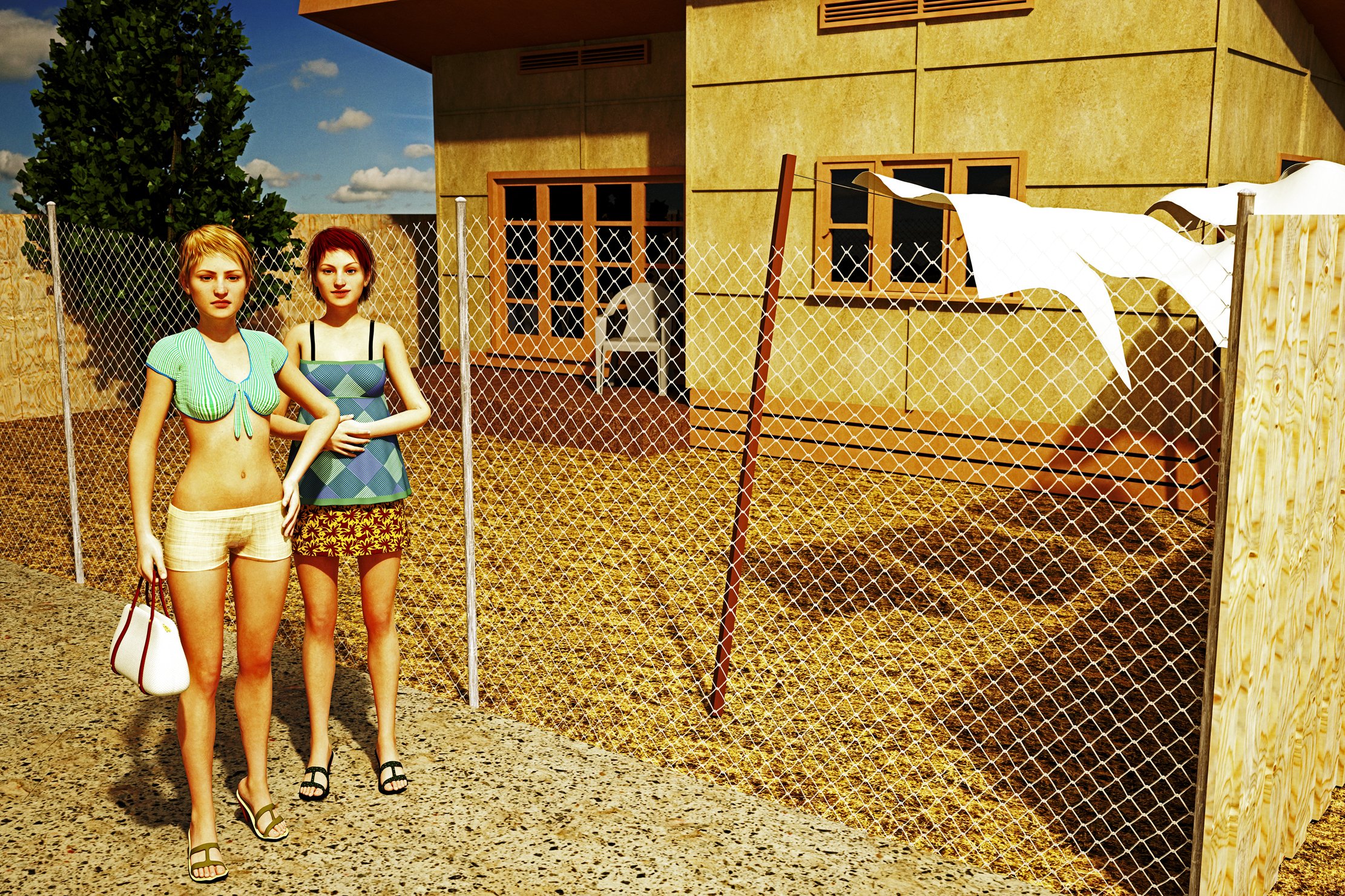
Street View Print on aluminium 605 x 910mm Edition of 5 - $3,500 296 x 444mm Edition of 5 - $1,000 148 x 209mm Edition of 5 - $500 The massive collection of data for the Google Street View project inadvertently captured images of people engaged in unexpected activities while others, such as street sex workers, were photographed plying their usual business. Although the company was quick to mask their identity, photography enthusiasts appreciative of the unmediated rawness of the material saved the more eye-catching examples and this reimagining combines some of those social themes. The dusty yards, broken pavement and chain link fences that forms this urban landscapes tells stories of low incomes and low expectations. This reimagining features a flat and dreary landscape under a harsh midday light. It’s occupied by a fibro-cement clad house fronted by a brown summer lawn, a solitary hardy tree provides no shade and a cheap plastic chair offers little comfort for the sitter, they are certain indicators this real estate isn’t particularly desirable. The girls, one of who warily regards the camera while her friend spontaneously smiles for it, could be working or they could be going out for a bit of action.

The Count Print on aluminium 605 x 910mm Edition of 5 - $3,500 296 x 444mm Edition of 5 - $1,000 148 x 209mm Edition of 5 - $500 The artist Christian Schad is noted for the portraits he painted during the 1920’s Weimar Republic period in Germany. They are typically descriptive and Schad didn’t resile from depicting his subjects’ sexual preferences. In the spirit of the republic’s sophisticated decadence, the count evidently had a liking for transvestite men as well as women, he was a man who, according to Schad, “was someone who could live only in a metropolis.”I’ve chosen a classically formal representation of the trio in this recreation that suggests the power imbalance when the wealthy and influential indulge in transactional sex. The count looks comfortable with his hands casually stuffed in his pockets while his consorts stand stiffly and expressionlessly by his side. Dressed in their diaphanous gowns they reflect their role as sexual objects easily accessible for the count’s pleasure.

The Outsider Print on aluminium 605 x 910mm Edition of 5 - $3,500 296 x 444mm Edition of 5 - $1,000 148 x 209mm Edition of 5 - $500 The Outsider was originally driven by the investigation of a 3D modelling technology called photogrammetry which is based on extracting a 3D model from a series of photographs. I live close to an ocean beach and during my regular walks I began to conceive of a project that married the idea of landscape with the human condition and where I could test the possibilities of photogrammetry software. The Outsider, a novella by the French writer Albert Camus, describes an incident when a French Algerian citizen arbitrarily murders an arab man on the beach. The philosophic core of the story hinges on Camus’ theory of absurdism, free will, morality and existentialism. These are weighty themes that are tough to visualise so I decided to focus on the solitary individual pondering his existence under an indifferent sky; simply put, the universe doesn’t care about any person’s life. The boulders, which were captured using photogrammetry, are set against a building storm and this landscape is intended to re-enforce the notion of a godless universe, a feeling I sometimes reflect upon during my walks which fortunately favour an appreciation of the natural world.
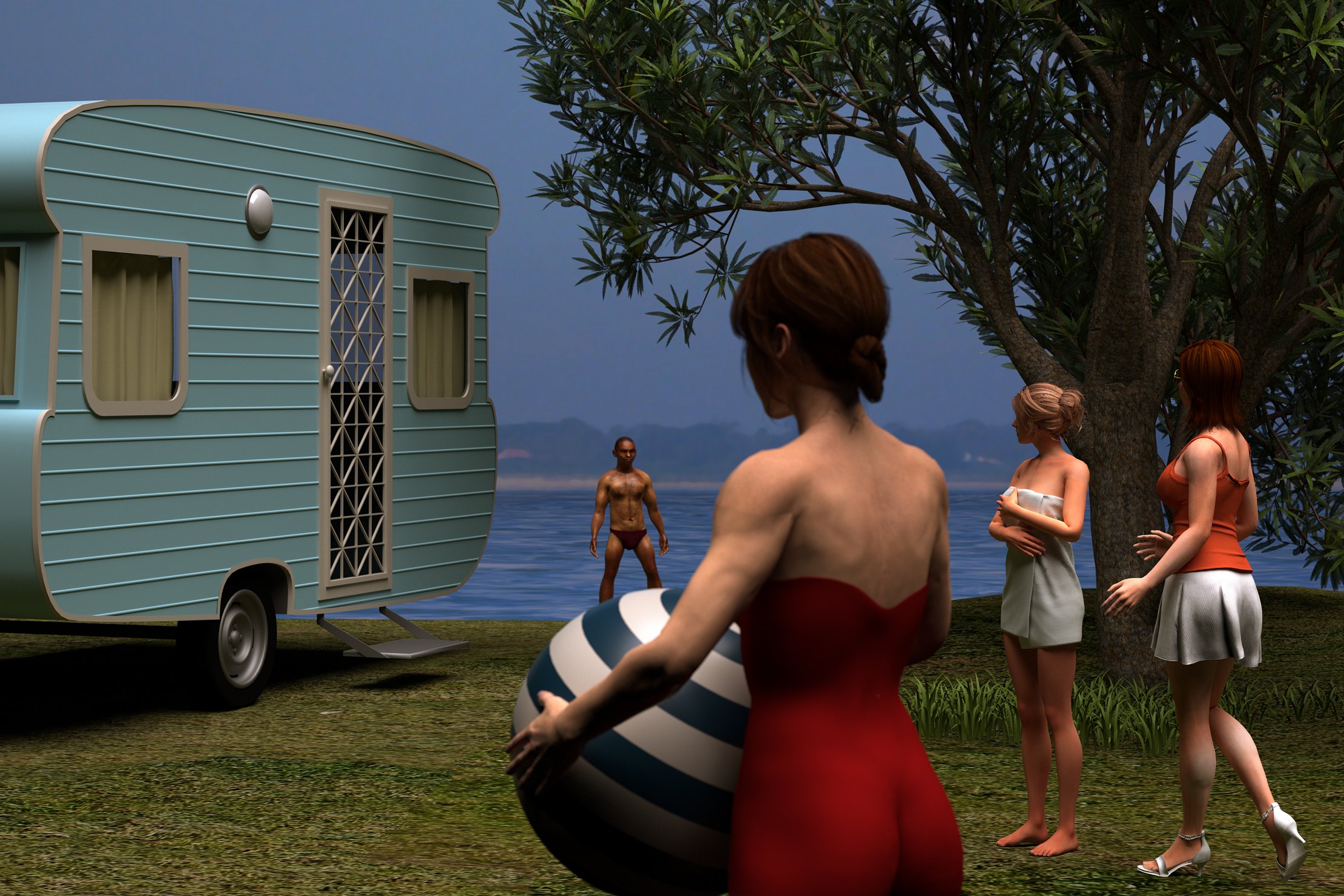
Way down in the hole Print on aluminium 605 x 910mm Edition of 5 - $3,500 296 x 444mm Edition of 5 - $1,000 148 x 209mm Edition of 5 - $500 This print was originally inspired by the theme music of the television series, The Wire. The song, penned by Tom Waits presents the life choices an individual can make in stark religious terms; by keeping the devil way down in the hole, bad choices such as drug addiction and criminal behaviour are avoided. The first version I made exploring this idea featured a suburban house at night when a muscular naked demon accosts a startled office worker returning home from work. This encounter between a law abiding citizen and a malevolent demon worked well enough but there were problems, the foremost being the demon sporting an aggressively prominent penis made it problematic for public exhibition, nonetheless I kept the file of the 3D scene. The following year I started work on a beach scene based on photos I had taken of a local camping ground. I soon found that this pleasant sunny scene missed a context which made it anomalous in this series where dark themes dominate. The solution was to extract the devil figure from the abandoned work and insert it as a disruptive element into this new project. The women’s holiday enjoyment is abruptly disturbed by the intrusion of this unwanted presence; one woman defensively wraps herself in a towel, another freezes mid-step while the female in the foreground protectively holds a beach ball when they spot the ‘devil’ emerging from the water. It reveals the unpredictable event we subconsciously dread when normal life takes a fateful turn.

The Census Taker Print on aluminium 605 x 910mm Edition of 5 - $3,500 296 x 444mm Edition of 5 - $1,000 148 x 209mm Edition of 5 - $500 China Mieville’s 2016 novella, This Census Taker, presents a world unlike any other postapocalypse future considered in this series of reimaginings. A young boy relates his story and the reader soon learns that he is an unreliable witness to events that make little sense in a world that is at best only vaguely comprehensible. The boy lives on a barren mountain with his emotionless mother and a father prone to episodes of psychopathic behaviour which the boy (and the reader) assume leads to the disappearance of his mother, presumably to join numerous small animals thrown into a deep pit by the enigmatic man. This event is a core of the narrative; however, typical of this book, it is presented without explanation as it joins the shrouded logic of much what occurs in this mysterious and evocative tale. The boy joins a group of children who live in a village in the valley, they catch bats from a bridge using bamboo poles and my initial inclination was to focus on this scene for this reimagining, but it was the isolated hut seen in a softly liminal light and the melancholic landscape which is the emotional linchpin I ultimately decided upon. The kneeling boy has found a key which was probably dropped by his father who makes them for a living while his mother, who we never get to know, watches impassively.

le Mepris Print on aluminium 605 x 910mm Edition of 5 - $3,500 296 x 444mm Edition of 5 - $1,000 148 x 209mm Edition of 5 - $500 This reimagining strayed so far from its source that there is barely any point of reference left. Normally this would concern me, but as with many of the prints in this series I start out with a broad agenda to allow the work to develop a life of its own, so there is always a risk of that outcome. As it stood, I liked the result mainly for its visual style even though any narrative elements are residual. As with much of Jean-Luc Godard’s New Wave work, his film Le Mepris can be read on many levels, one of which echoed the breakdown of his marriage. The man in this image is so absorbed in reading that he has his back turned on his wife and the exotic surroundings. The latter half of Godard’s film is set in the extraordinary 1930’s rationalist house Casa Malaparte which is built on a vertiginous headland on the isle of Capri and here it has been substituted with a stark empty modernist box devoid of any furnishings that could be seen as a metaphor for the couple’s floundering relationship and a hollowed out modernity. The ancient statue hints at a richer past. This perception was noted in a review of the film by the New Times critic Bosley Crowther who wrote, “Mr. Godard has attempted to make this film communicate a sense of the alienation of individuals in this complex modern world.”

Jesus Franco Eurotrash Print on aluminium 605 x 910mm Edition of 5 - $3,500 296 x 444mm Edition of 5 - $1,000 148 x 209mm Edition of 5 - $500 I have long been a exploitation cinema enthusiast and this reimagining of the lurid Jesus Franco movie, She Killed in Ecstasy, is very much in the same vein as a previous print in this series, The Daughter of Fu Manchu. Key features of this style of cinema are the ramping up of sex and violence and Franco showed very little restraint in this department. What is notable about She Killed in Ecstasy are the stylish sets and locations that reflected European avant-garde taste of the 1960’s and 1970’s. One example is Spanish architect Ricardo Bofill’s exquisite architectural statement, Xanadu, which is featured prominently in the latter half of the film but unfortunately I decided to omit it because of the difficulty involved with building the 3D model. Instead, for the exterior view I inserted the sort of generic holiday apartments designed for the package holiday tourist typical of the Spanish Mediterranean coast. I had no such problem with recreating the famous ‘Blow Chair’ which is the piece of inflatable furniture which prominently occupies the foreground of the composition. Its inclusion is intended to impart a certain sensuality which I suspect doesn’t translate into actual comfort in real life. Unlike Franco, who wastes little time propelling the action into the direction expected by the audience of exploitation cinema, I decided pose the two women at the point they are assessing one another’s desirability with the woman on the right signaling her desire by slightly spreading her legs and the woman in the foreground lifting her foot as a sign of consent.
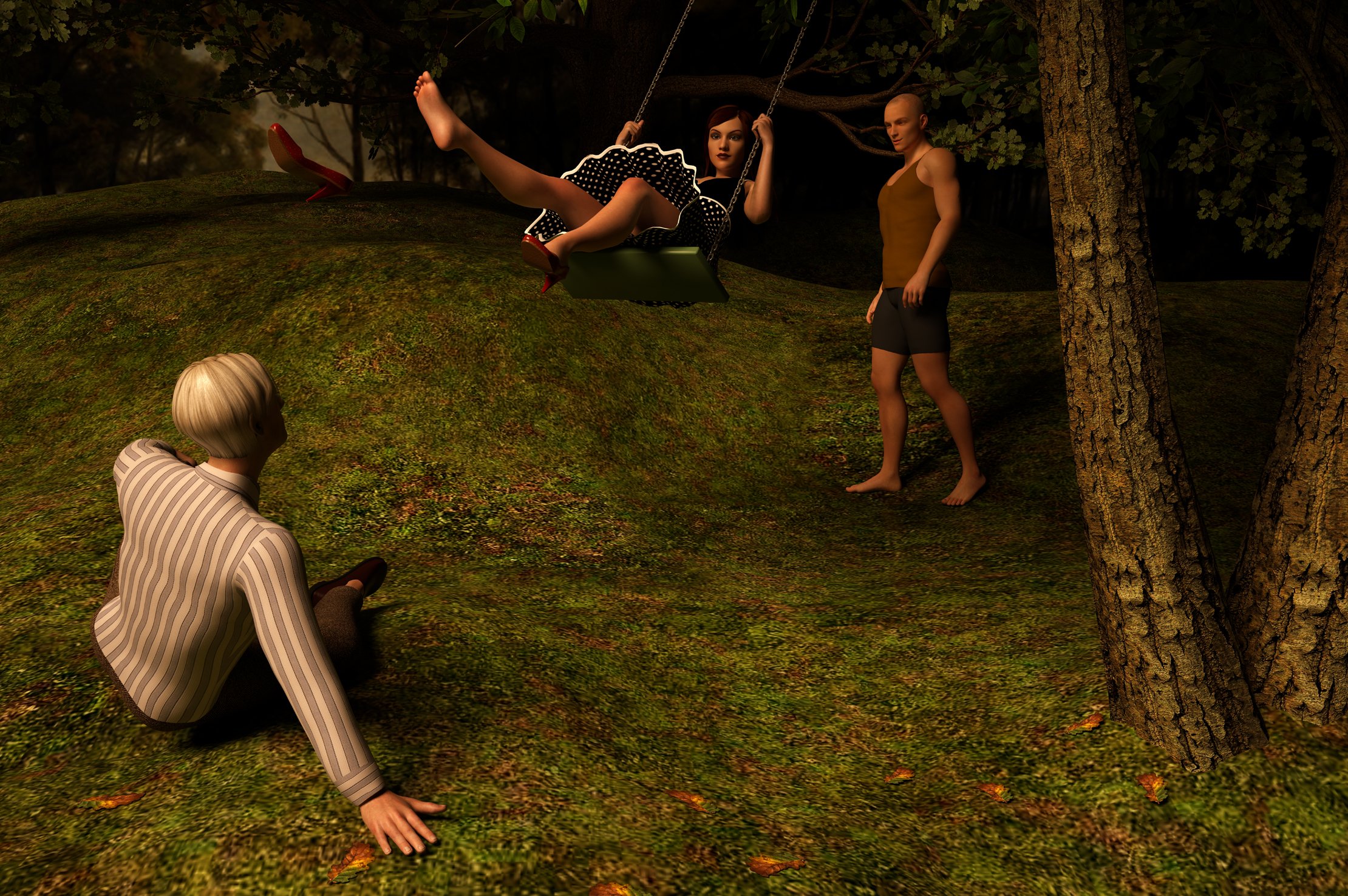
The Swing Print on aluminium 605 x 910mm Edition of 5 - $3,500 296 x 444mm Edition of 5 - $1,000 148 x 209mm Edition of 5 - $500 The Jean-Honore Fragonard painting, The Swing, is a memorable Rococo confection of delicate colour which depicts an aroused nobleman spying on a young woman on a swing. Her flouncy dress parts in the breeze, the artist suggests what he might see and it’s unclear whether she is complicit in a game of exhibitionism or a victim of voyeurism. This ambiguity has long fascinated scholars but readings of art can be subjective and are conditional of the values of the period in which they are made; one interesting interpretation comes from Clive Hart and Kay Stevenson who write in In Heaven and the Flesh: Imagery of Desire from the Renaissance to the Rococo that The Swing is a “disguised representation of inverted sexual intercourse.” It’s the woman who is on top in this potential ménage-à-trois. I wasn’t aware of the article when I made this reimagining hence I was quite pleased when a female friend detected this frisson when I showed it to her. Another reason for making this was the forested setting and the technical challenge it presented in convincingly depicting such an environment.

The Back Verandah Print on aluminium 605 x 910mm Edition of 5 - $3,500 296 x 444mm Edition of 5 - $1,000 148 x 209mm Edition of 5 - $500 Russell Drysdale’s 1942 painting, The Back Verandah, is a fairly minor yet charming work typical of the Australian outback subjects that he was known for. It is a portrait of a blue collar family seen at the back of their traditional Australian weatherboard cottage replete with a bench casually draped with a bed sheet, a millet broom, a towel hung on a nail hammered into the boards and discarded car tyres reused for plant pots in the dusty backyard. I have always had a fondness for this painting because its subject matter is familiar to me from the time spent living in the Australian bush in the 1950s when I was a child. This reimagining also serves as a reminder of the former mythologising of rural Australia before this country’s population became resolute urban coastal dwellers.

The Lictors Print on aluminium 605 x 910mm Edition of 5 - $3,500 296 x 444mm Edition of 5 - $1,000 148 x 209mm Edition of 5 - $500Jacques-Louis David had a gift of creating visual art that served the goals of the French Revolution in the late eighteenth century. Although his cool Neo-classical style doesn’t make for cosy art it certainly has an impressive formal power and it generally avoided crude political hyperbole. His painting, The Lictors Bring to Brutus The Bodies of His Sons, moralises about the virtues of upholding the ideals of the state even when it condemned Brutus’ sons to death for treason. It’s a solemn art work that exposes the horror and grief experienced by his family and it’s the section of this epic canvas detailing the reaction of his wife and daughters which I chose to focus on for this reimagining. The result is an odd mishmash of elements partially faithful to the David painting such as the background of heavy Roman columns, 1940s furniture which I thought most closely resembled David’s notion of Roman interior style and the trio dressed in clothes fashionable twenty years ago. The sheet strung up on the columns presented a mild technical challenge which I solved by photographing some bed linen hung from the back verandah of my house and saved for use as a texture map.

Riot Print on aluminium 605 x 910mm Edition of 5 - $3,500 296 x 444mm Edition of 5 - $1,000 148 x 209mm Edition of 5 - $500The Ronald MacDonald doll, which was designed to draw young children to the McDonalds hamburger franchise, is a powerful corporate symbol. It can be viewed as representation of a culinary wasteland where the Golden Arches dominate the skyline of busy main roads cutting through newly built suburban tracts. In non-western countries MacDonalds seems quite alien, hence it’s unsurprising that when anti-western sentiments erupt McDonalds and KFC become primary targets. It was images of rioters burning a Ronald McDonald doll and tossing KFC buckets in the streets of Karachi which triggered this reimagining. The interpretation turned out to take on a ritualistic appearance unlike the chaos captured by the news photos. The rioters in these images wore the traditional shalwar kameez gown but I had no interest in a literal interpretation and dressed them in gym suits and baseball caps which imparts a paramilitary look and a seriousness of intent. Their pale blue outfits are part of a carefully structured colour palette with the inane Ronald McDonald lying on his future pyre in his usual colourful livery becoming the centre of attention. The grey silent observers ringed around the action look as if they are cast from concrete while the dreary car park is lit in a dull brownish light.

The Siege Print on aluminium 605 x 910mm Edition of 5 - $3,500 296 x 444mm Edition of 5 - $1,000 148 x 209mm Edition of 5 - $500 The Siege was inspired by a 1911 photo showing a group of army riflemen and police officers laying siege to an East London house during a shootout with two Latvian anarchists. The event was notable for the presence of the British Home Secretary, Winston Churchill, who attended mainly out of curiosity rather than in an official capacity. The event was also notable as an early manifestation of political terror in a city tolerant towards refugees and it led to calls for the restriction of asylum seekers from the volatile regions of Europe. I chose to follow the original photo’s striking composition of the men, protected against the weather by heavy overcoats, staring in the direction of the gunmen. The simplified colour palette of muted grey, blue and brown is intended to respect the monochrome origins of the image and the psychological wintriness of inevitable death in a bleak urban landscape.

Canticle for Liebowitz Print on aluminium 605 x 910mm Edition of 5 - $3,500 296 x 444mm Edition of 5 - $1,000 148 x 209mm Edition of 5 - $500 A previous work in this series is based on the Russell Hoban novel Riddley Walker, it is a challenging read about a possible fate that could befall civilisation. An equally testing read informed this reimagining; Canticle for Liebowitz. It was written by Walter M. Miller and it is based on the existential horror the young American bomber crew member experienced during the World War Two bombing of the sixth century monastery at Monte Cassino and it inspired his strikingly original vision of a post-apocalypse future. Canticle For Leibowitz is difficult to characterise; it’s profoundly thoughtful, frequently surreal, oddly comic and always thoroughly inventive. Slabs of latin exegesis punctuate memorable scenes such as breathless monks powering a hamster wheel to run a dynamo used to generate electricity for a single dim light globe. The monks labour for years on an illuminated manuscript copy of a holy relic, basically a blueprint of an electronic device discovered in some ruins and designed by an electrical engineer who is soon to be canonised as St. Liebowitz. it’s a document whose original purpose is completely obscure to the reverent monks and we may assume it contributed to the nuclear disaster .The setting centres on an isolated monastery in a post apocalypse desert in the US, and this together with the novel’s religiosity settled one decision — that the lighting has a pinkish tint bathing a landscape entirely devoid of greenery, much like the Hollywood bible movies of the 1950s. The chosen moment is the unexpected arrival of the peripatetic figure of the Wandering Jew, a wise but puckish presence who regularly reappears over the novel’s time span of millennia, and who frightens the novice monk sent into the desert by his abbot to prove his fitness.The concrete debris scattered over the landscape carries ominously prophetic graffiti quoting texts such as the Bible, the Bhagavad Gita and the eminently quotable Winston Churchill. A half buried sign bears the name New Rome which has become the post-apocalypse seat of the Catholic church, the institution who historically became the guardian of knowledge after the fall of old Rome. The eroded head which has a likeness to Julius Ceaser, the hovering vulture and the dynamo are the type of talismanic and atavistic objects that populate Miller’s densely symbolic narrative.

Eight months on Ghazzah Street Print on aluminium 605 x 910mm Edition of 5 - $3,500 296 x 444mm Edition of 5 - $1,000 148 x 209mm Edition of 5 - $500 Much is left unsaid in Hilary Mantel’s 1987 novel, Eight Months on Ghazzah Street, because the narrator is unsure about what is happening in the unfamiliar world she has reluctantly made a home in. The novel is based on the four years the author spent living amongst the expatriate community in Saudi Arabia and the texture of the story is framed by her status as an outsider in a society whose morals and politics are baffling to her. She is constantly guessing what the events she witnesses mean and the attitudes of her expatriate colleagues don’t help, they are there for the money and their feelings towards their host society are dismissive and often contemptuous. This reimagining shows the narrator reading the local news on a tablet device, her slumped shoulders and the instinctive grasping of the knees suggest unease, the empty wine bottle and glass reveal the consumption to alcohol her community turns to as a means of coping. The room has the bareness of a temporary dwelling, it is decorated in an insipid monochrome colour and the air conditioner is a defense against the relentless heat bathed city seen through the blueish tinted windows. Outside, a spiked gate indicates distrust of strangers, a freeway overpass implies that this is not a pedestrian friendly city, a police car visible through the left window is a metaphor of an authoritarian society and the distant buildings represent the twin pillars of corporate and religious power. 15.

Daughter of Fu Manchu Print on aluminium 605 x 910mm Edition of 5 - $3,500 296 x 444mm Edition of 5 - $1,000 148 x 209mm Edition of 5 - $500 English novelist Sax Rohmer’s fictional character Dr. Fu Manchu is the archetypal super villain who sends stealthy assassins from his Oriental lair on missions to undermine western powers in his quest to further Chinese nationalism. The novels which embody the early 20th century colonial suspicion about Oriental political aspirations traded in stereotypes that were quite appealing to film makers working in a less politically correct era and who were purely interested in crude entertainment. One such film depicts Fu Manchu’s daughter instilling law and order with the aid of a lash in the doctor’s harem of comely looking western women who are predictably clad only in their underwear. I’ve long been an enthusiast of exploitation cinema but in my reimagining of the doctor and his daughter I’ve opted for a less salacious interpretation by presenting the ensemble of characters as a family portrait. The typical cinematic depiction of Fu Manchu as a lithe figure clad in a Chinese robe and cap and sporting a long thin moustache has been substituted by a muscular man dressed in a pale coloured business suit. With his stony expression and his hands hanging loosely by his sides, he exudes a powerful businesslike menace. His daughter is dressed in an elegant Chinese qipao and her stance echoes that of her dad as she is clearly following in his footsteps in managing the family business. The dacoit assassin stands in a military ‘at ease’ pose but his clothes are pure street thug and his position at the rear of the ensemble suggests both his stealthy profession as well as his lowly rank in the organisation. The middle aged female captive is presented as their prize, her seated position in front of her captors is characteristic of terrorist propaganda videos and her hunched posture recalls the passivity of prisoners uncertain of their fate. She is middleaged and it appears as if she has been yanked from comfortable suburbia into an unfathomable fate. She could represent senescent western nations struggling to maintain a prosperous and peaceful life in a politically unpredictable world but she is certainly intended as a poke at exploitation cinema that insists on comely young female actors with bountiful physical attributes. The objects in the room reflect the doctor’s polymath erudition and tastes but also symbolise his ambitions for power.

Harem Print on aluminium 910 x 605mm Edition of 5 - $3,500 444 x 296mm Edition of 5 - $1,000 209 x 148mm Edition of 5 - $500 The Harem was made in response to a video about North Korean dictator Kim Jong Un and his ‘Pleasure Squad.’ It’s a squad of the most beautiful women in the country who are there for the pleasure of that man only and the women are given no choice in the matter. The cliches dictators are prone to are visible in the background; the cult of personality golden statue includes a figure with a cape suggesting he is about to segue into a comic book super hero. The justification for his alleged quasi-divinity is neatly encapsulated by the latin inscription on the facade of the mock temple, DEUS VULT, God wills it.
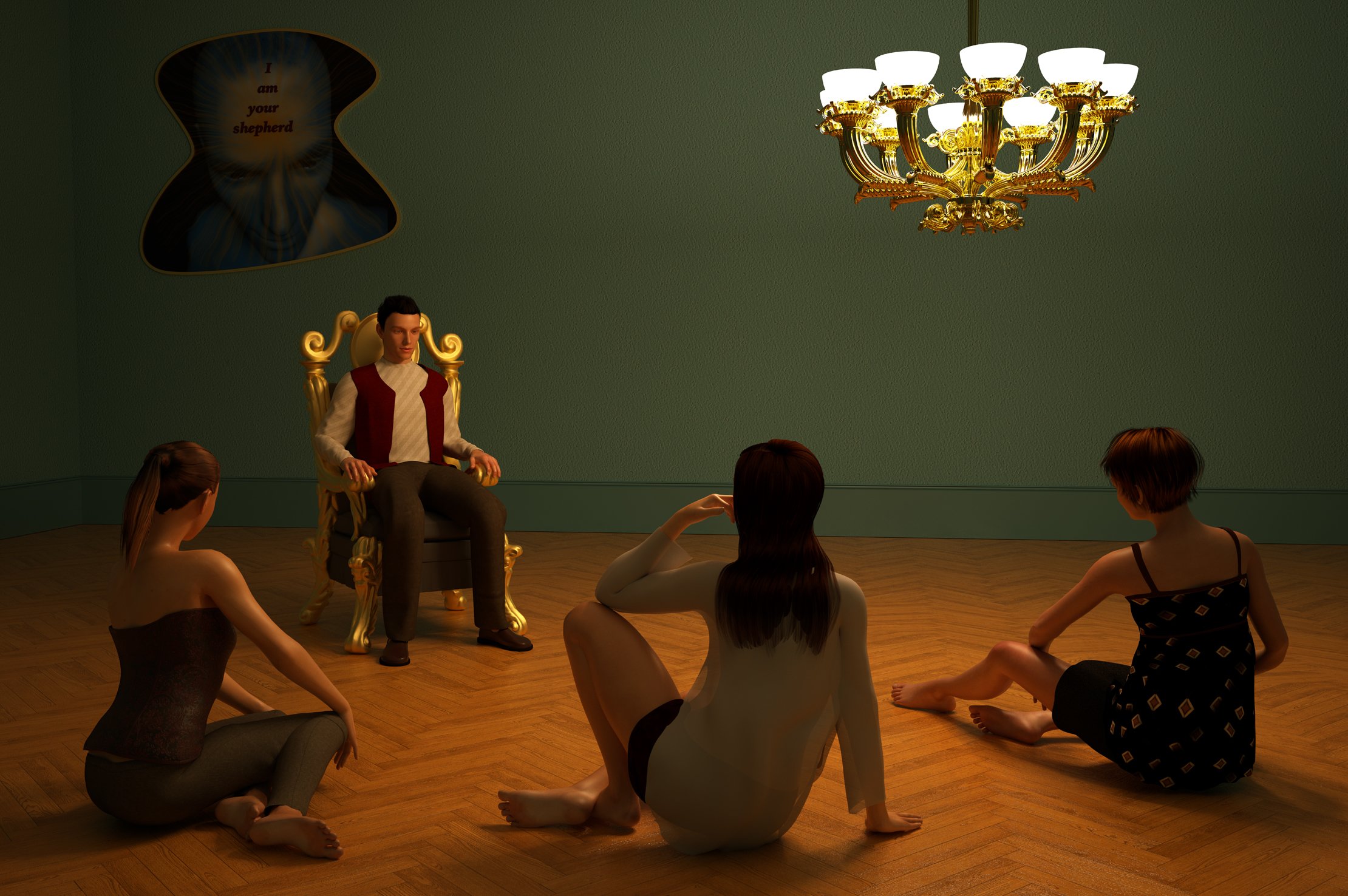
The Guru Print on aluminium 605 x 910mm Edition of 5 - $3,500 296 x 444mm Edition of 5 - $1,000 148 x 209mm Edition of 5 - $500 The theme of this print came to me after listening to a podcast about the Manson family who committed the murder of the actor Sharon Tate in 1969. The event shocked people at the time because the concept of a cult was relatively unknown and the mass suicide and murder of the Jonestown massacre, a decade later in 1978, confirmed the sinister implications of cult psychology. The scene depicted in Guru looks relatively benign, it could be a harmless therapy session or a lecture about spiritual matters until a symbol such as the golden throne, with its suggestion of power and dominance, is perceived as a subtext of the social transaction of the group. Equally disconcerting is the wall plaque above the guru, a cosmic head emanating golden rays from its third eye and the legend “I am your Shepherd” which appears like a brooding Big Brother figure scanning the proceedings in the room. The weird shape of the plaque is intended to imply distorted meaning or a thought bubble reflecting the guru’s true agenda. The women are young and innocent, ideal as recruits into a cult to satisfy the leader’s sexual appetite and to attract men into the group, which was a strategy that Charles Manson used. The guru’s collarless shirt and vest were chosen partly as a reference to priest’s garb but more so as the type of clothing the wolf wears to mask his true purpose.

Ridley Walker Print on aluminium 605 x 910mm Edition of 5 - $3,500 296 x 444mm Edition of 5 - $1,000 148 x 209mm Edition of 5 - $500 The Russell Hoban novel Riddley Walker stands out for its singularly imagined post-apocalypse England. Language has broken down into a crude argot which Riddley uses to narrate his story, the survivors fear feral dog packs, they unearth old machinery so that the metal can be refashioned into primitive tools and entertainment consists of Punch and Judy shows and Riddley’s narration of the legends that serve as a warning against the use of the atom, the cause of their downfall. The legends he narrates speak of the atom as the “Li’l Shynin’ Man” who appears in this print between the antlers of a deer in the figure of tiny metallic man whose arms are outstretched in the form of a cross, a symbol about belief referencing the conversion of St Eustace to Christianity. The workers who have been busy digging out rusty old machines watch this phenomenon transfixed. One worker has the logo ‘Guy Montag’ on the back of his sweater which is a reference to the dystopian book burner described in the Ray Bradbury novel Fahrenheit 451. The company name Deckard which is stencilled onto the oil drum is the name of the replicant hunter in another great novel about a dystopian future, Phillip K. Dick’s Do Androids Dream About Electric Sheep, familiar to many speculative fiction fans through the Ridley Scott movie adaption, Blade Runner.

The Floor Print on aluminium 605 x 910mm Edition of 5 - $3,500 296 x 444mm Edition of 5 - $1,000 148 x 209mm Edition of 5 - $500 I generally despise social media except when I can engage with someone who is particularly knowledgeable in an area that intrigues me. One such person is a Russian man (I’ll keep him anonymous) who worked for the Ministry of Propaganda during the Soviet era. He also had access to a fascinating image archive. A follower of this man quizzed him about the decline of Russian manufacturing and he mischievously included a photo of factory shop floor shenanigans with his answer. It depicts a male floor manager fondling the breasts of a laughing female machine operator while an amused female coworker looks on. It’s behaviour that anyone who has endured mind numbing industrial process work would probably have witnessed in an age before such behaviour would have resulted in legal action. I have witnessed such behaviour when I worked in a press shop and the architecture of the industrial plant I have depicted does include a press in the background. The art work is a homage to all bored process workers who still exist in this post-industrial age and a remembrance of my teenage years when the sons and daughters of the working class joined their parents on the factory floor, hopefully only for the school holidays.
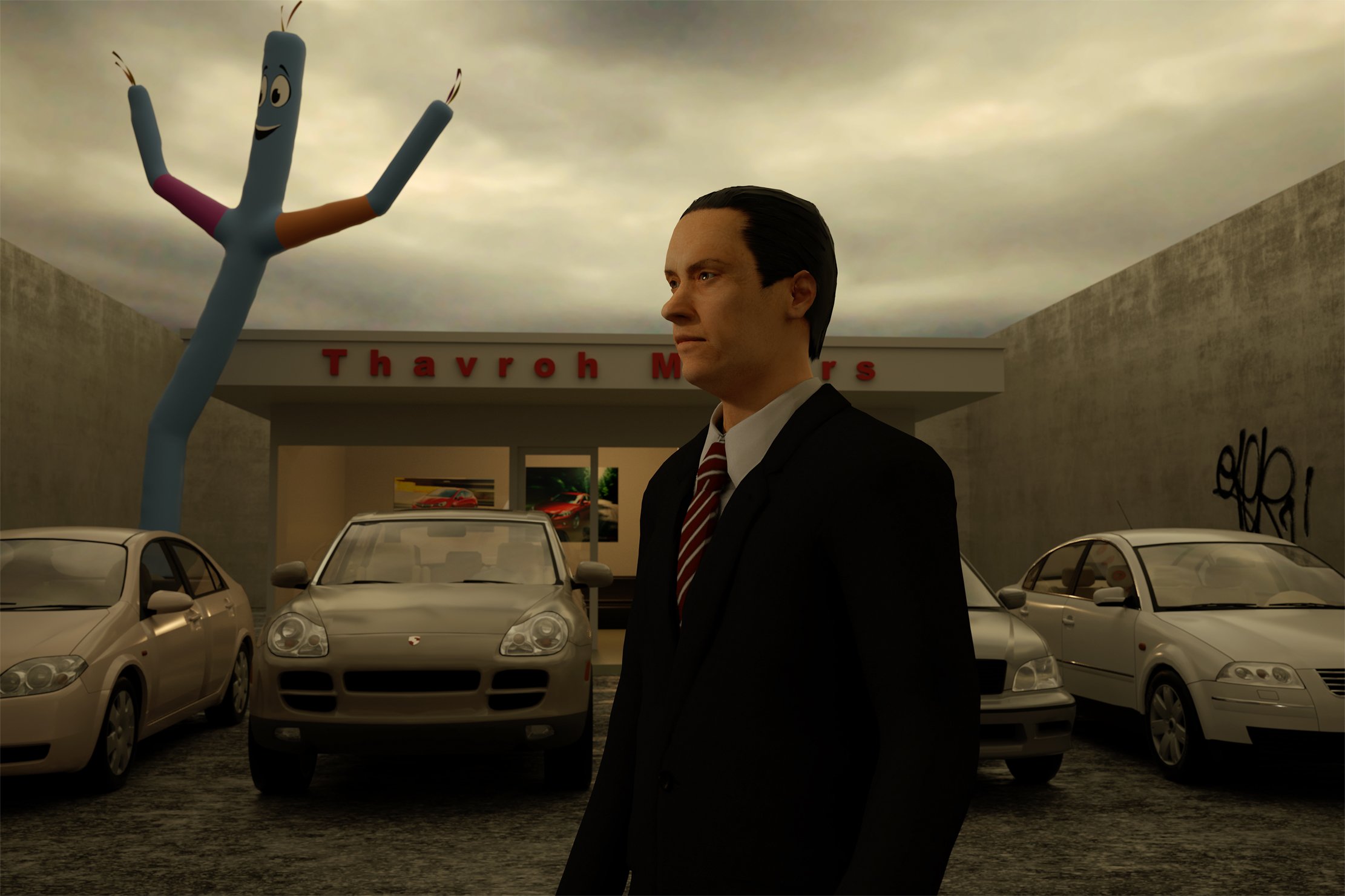
Parker Print on aluminium 605 x 910mm Edition of 5 - $3,500 296 x 444mm Edition of 5 - $1,000 148 x 209mm Edition of 5 - $500 Parker is the criminal protagonist of a series of novels by Richard Stark, a nom de plume of the author Donald Westlake. Parker is an amoral blank who is ruthless and efficient in his pursuit of money, an existentialist everyman inhabiting a landscape of generic American towns, a man without identity and emotion. The criminal tools of his trade are a gun and a car, hence the choice of situating him scoping out a vehicle in a dreary car sales lot wedged in by colourless concrete tilt slabs; it’s a monochrome place festooned with an inane inflatable happy face advertising man. This setting was informed by the photos of the American photographer, Stephen Shore, with his images of quotidian urban landscapes from his book Uncommon Places. Another notable influence was the 1967 John Boorman film made about Parker, Point Blank, where the city plays a significant role in situating his persona in a soulless corporate environment. For anyone wondering about the car dealer’s name, it’s an anagram of my surname, a choice dictated by my inability to think of anything better.
The Voice, Digital Print on Aluminium, Edition 5, 60 x 90 cm, $3,500 Edvard Munch's psychologically haunting art has always been a favourite of mine and I kicked off this series of digital prints reimagining The Voice, sometimes known by its alternative title, A Summer Night's Dream. Finding an interpretation I was happy with proved to be incredibly elusive despite several reworkings. The simulated depth of field which resulted in the blurred background helped suggest the marginal light atmospherics and pushing the figure to side of the picture plane relieved the rigidity imposed by the horizontal and vertical background elements. Ironically, the minimalism of The Voice which initially made it appear to be a safe choice proved to be unpredictably problematic. Edvard Munch, The Voice: Museum of Fine Arts, Boston
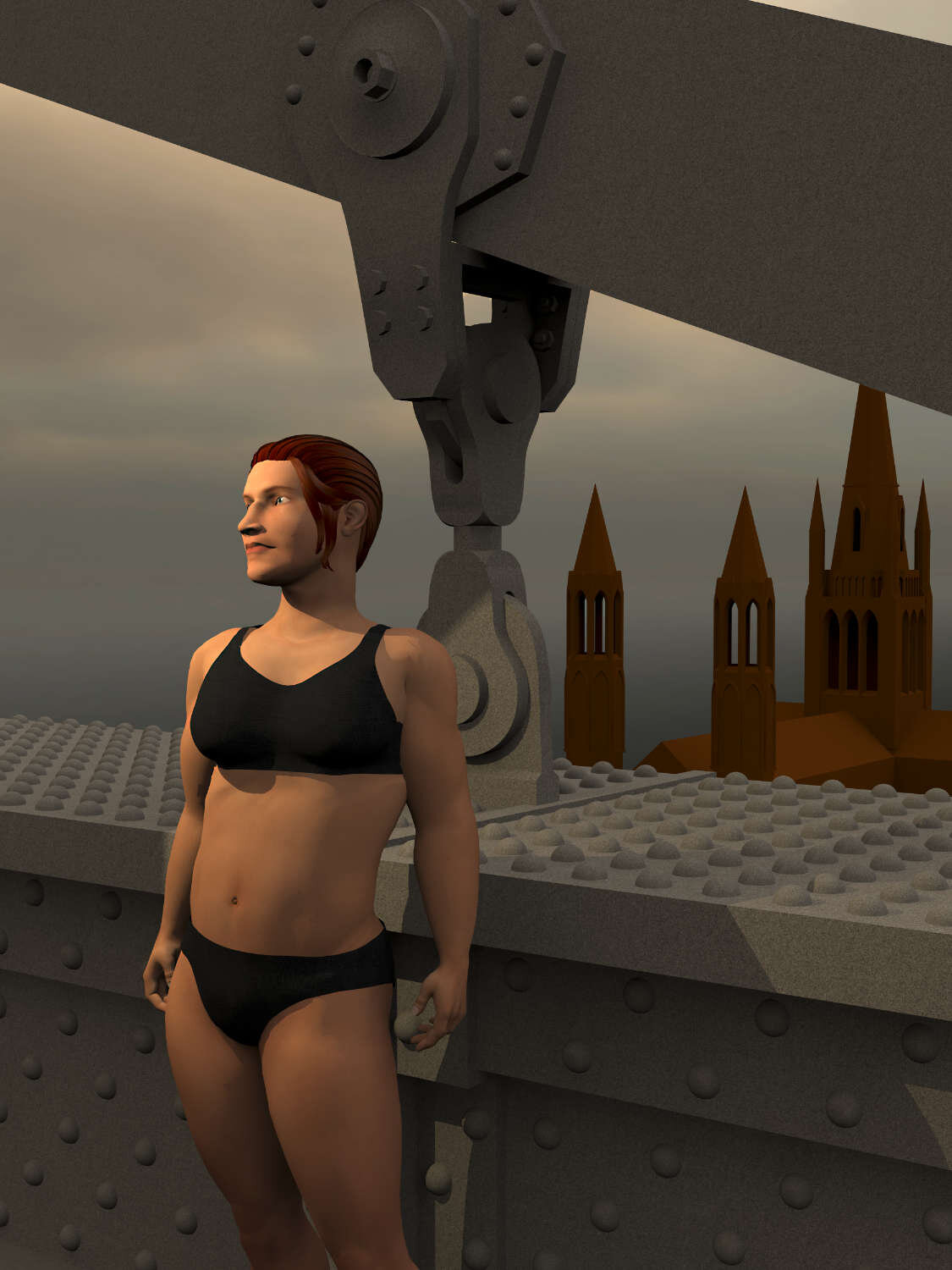
The Swimmer of Cologne, Digital Print on Aluminium, Edition 5, 60 x 90 cm, $3,500 The New Objectivity or New Sobriety cultural movement of the 1920's German Weimar Republic held an immediate fascination for me when I first encountered it. As the name suggests, artists associated with it framed society through a lens of objectivity rather than the romanticism of the German Expressionists a decade earlier. The bitter legacy of the First World War and the consequent social upheaval led these artists to favour an incisive look at the volatile culture and politics of their country. The work they produced was regularly explicit about sexuality, damning of authoritarian politics or straight out oddball, such as Karl Hubbuch's Swimmer of Cologne whose iconography still baffles me. Why pose a squat and inelegant figure in front of an impressive piece of industrial architecture studded with rivets and the beautiful Cologne cathedral in the background?

The Bathroom Digital Print on Aluminium, Edition 5, 60 x 90 cm, $3,500 John Brack’s 1957 painting, The Bathroom, quite subversively depicts one of the least sensuous nudes in western painting. Although the artist's characteristic wryness is appealing -- Brack never idealised his figures -- it was the explicit architectural detail of the Australian Edwardian bathroom, with its vivid palette of green, pink and yellow, which made this painting an enjoyable choice for a re-imagining. Brack’s earlier work had an almost prototypical pop art flavour focused on portraying urban Australian life in the 1950’s and 1960’s. That era of his art presented a cool, cerebral exploration of quintessential Australian public activities such as ballroom dancing, horse racing, drinking in public bars and his classic depiction of rush hour workers departing the city of Melbourne.
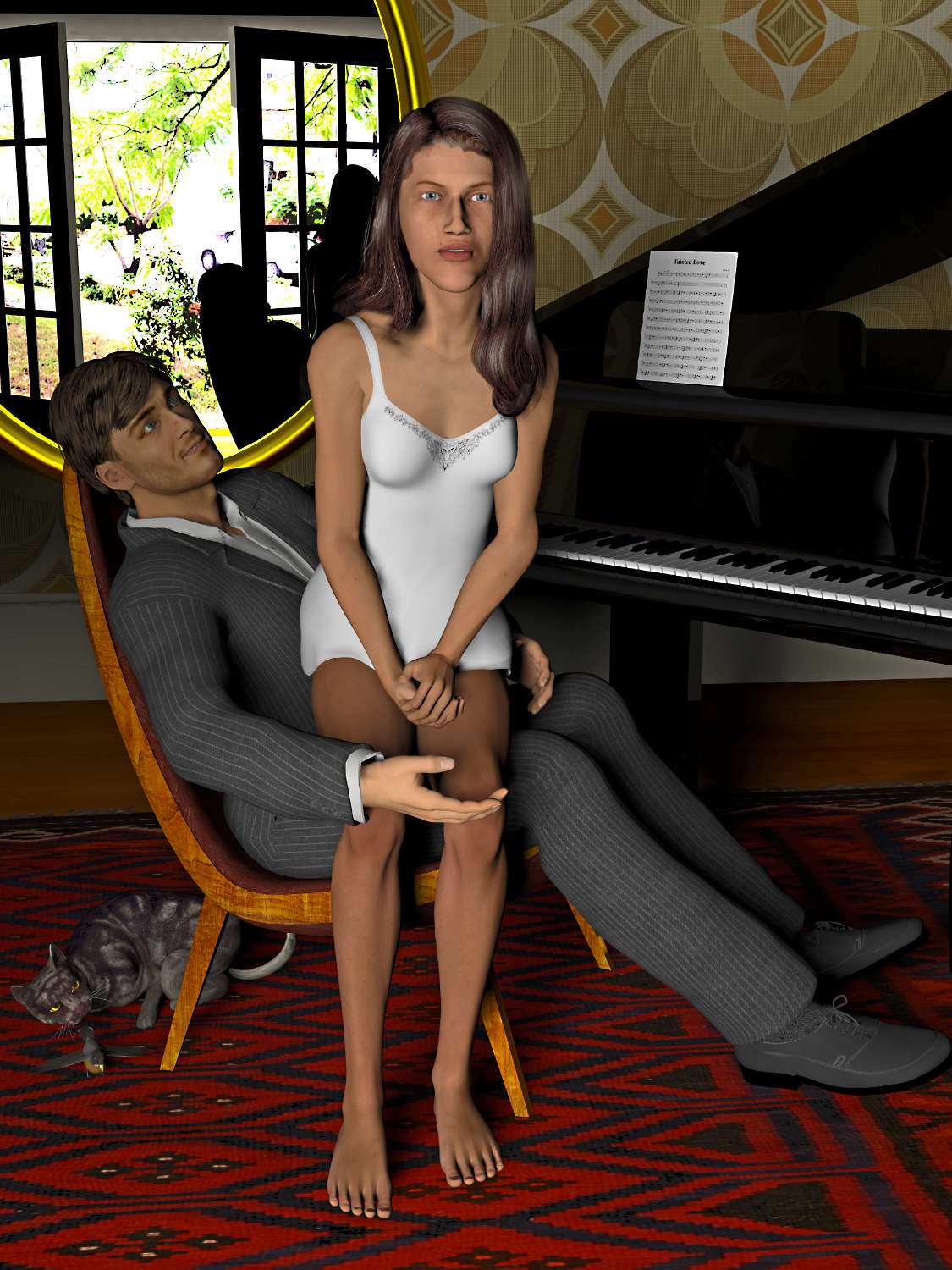
The Awakening - Conscience, Digital Print on Aluminium, Edition 5, 60 x 90 cm, $3,500 During the 1970's when I was an art student, my interest was piqued by an art movement that had been quite deliberately ignored by my lecturers in art history discussions. The Pre-Raphaelite Brotherhood, a British Victorian art movement, presented a visual language completely at odds with the values of modernist thinking, the Pre-Raphaelites like to project moral values using an aesthetic that prized clarity of detail in lush oil paint. William Holman Hunt's 1853 painting, The Awakening Conscience, is an interesting example of this Victorian moralism, however it is based upon a conceit. It shows a young woman experiencing an epiphany; if she submits to the man's sexual invitation she will likely become a fallen woman who may need to resort to prostitution once he has tired of her, a fate seen as a punishment for immorality in strait-laced 19th. century England. The model Hunt used for his painting was his 15 year old girlfriend. Hunt's painting is embedded with symbolic clues that re-enforce this narrative and a couple I've chosen to include are the cat toying with a small bird and the song sheet on the piano, here updated to the great 1960's Motown classic, Tainted Love. The cloying busyness of Hunt's bachelor pad has been toned down somewhat for this reimagining to suit a more twentieth century sensibility. 1970s wallpaper frames a simple gilded mirror reflecting a sunlit garden which beckons the woman to escape from her potential corruption.

The Art of Painting, Digital Print on Aluminium, Edition 5, 60 x 90 cm, $3,500 I have long been mesmerised by the dramatic compositional power of the drawn back drape that reveals the tranquil scene of the artist at work painting his model. Johannes Vermeer's work has a rare, indefinable otherness that really became apparent after I viewed the small collection of his work at the Queen's Cabinet of Paintings in the Mauritshuis in The Hague. I wasn't sure what I hoped to achieve when I set out recreating this enchanting work but it became apparent when scaling the models and testing the lighting that the belief Vermeer availed himself of a camera obscura to compose the perspective and tonality of his paintings is quite plausible. Vermeer's familiarity with the science of optics is unsurprising, the Netherlands during this period explored any knowledge which could enrich the country and this included cartography. The artist had placed a map in the background of The Art of Painting and I have updated it for our age by inserting a land use satellite map of the same region of the Netherlands.

Room in Brooklyn Digital Print on Aluminium, Edition 5, 60 x 90 cm, $3,500 There is a stillness, mystery, and a mood of melancholy in Edward Hopper's most characteristic work of paintings posing a question without obliging an answer. His pictures evoke a very strong sense of place, a visual urban poetry that is firmly anchored in the physical world yet hint at a timelessness and otherness. I suspect that I chose to reimagine this subject because of my memory of living in a European city when I was in my twenties and the strange sense of ennui I often felt gazing out the window overlooking a street of uniform apartments.

The Finding of The Body of St. Mark, Digital Print on Aluminium, Edition 5, 60 x 90 cm, $3,500 I've never investigated the events Tintoretto depicted in his 1562 painting, The Finding of The Body of St. Mark. Instead, my interest was piqued by the architecture of the building as a dramatic stage for an event which I treated more like a news report rather than momentous biblical history. The drama of Tintoretto's painting has by necessity been toned down for technical reasons because the computer I used could not handle complex scenes without a struggle. Beside the reduced cast of characters the tombs and vaulted arches have been copy and pasted into the composition appear making it appear more monumental despite using minimal resources.
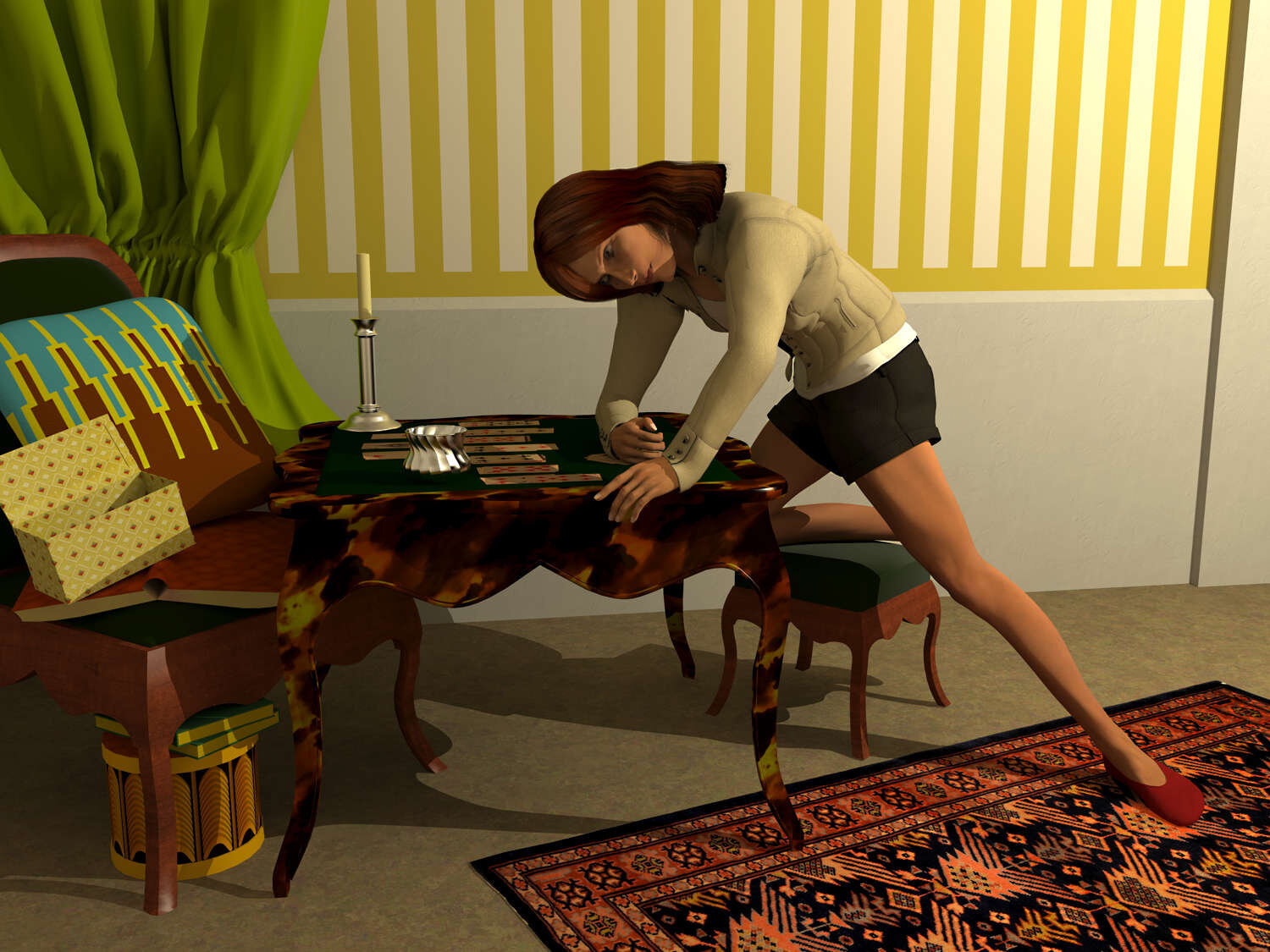
Patience, Digital Print on Aluminium, Edition 5, 60 x 90 cm, $3,500 Balthus (Balthasar Klossowski de Rola) is an unusual figure in 20th century art. He is a classicist rather than a modernist and his voyeuristic depictions of teenaged girls exuding a disturbing eroticism would probably land him in prison if he had painted them today. These qualities are implicit rather than overt in his 1943 painting, Patience. The disarray of the objects and the hunched pose of the girl suggest a pent-up energy and frustration with her playthings and the confining atmosphere of the bourgeois parlour. In this reimagining I decided to focus on the composition of the radically slanted figure in the room with it's furnishings and objects. The striped wallpaper, the lacquered tortoise shell wood table, the chartreuse green drape, the patterns on the pillow and rug, the decorations on the boxes and book cover were calculated to crisply beef up the quiet monochromatic mood of the original.

Jacob Wrestling The Angel, Digital Print on Aluminium, Edition 5, 60 x 90 cm, $3,500. Originally this reimagining of the Eugene Delacroix painting, Jacob Wrestling the Angel, was set at night with the figures portrayed as surfer types engaged in a wrestling match while in the background traffic goes about its business along a busy road heedless of the drama being played out. It was a nice idea, placing a mythical entity such as an angel in an environment that any urban dweller is familiar with, and despite much fooling about with lighting and moving figures around the composition I found the idea was impossible to realise sucessfully and opted instead to locate the action in a serene morning landscape. While this result misses the cultural jxutapostion presented by the original idea, the reduction of the composition into the simple elements of the figures locked in combat set against the greenery focused attention on fundamentals. Even though the combatants have fought throughout the night, Jacob is energetically pushing hard against the angel, almost pushing him off the little patch of grass hemmed by the shrubbery which acts as a makeshift wrestling ring. The wrestlers' haircuts and summer clothes together with utility pole visible in the top right corner are a reminder that this is a modern take of an ancient mythical contest.

En Cas de Malheur, Digital Print on Aluminium, Edition 5, 60 x 90 cm, $3,500. I have only seen excerpts from the 1958 Claude Autant-Lara film, En Cas de Malheur, and those segments strike me as somewhat overwrought. However there is one very spicy scene with Brigitte Bardot, sans panties, which has earned it notoriety and, briefly, censorship in English speaking countries. It was during my childhood and teenage years when Brigitte Bardot played the sex kitten in European films from the 1950s to the 1960s, so she has a mythological status which has stayed with me into adulthood. Another reason for reimagining this film is the writer who wrote the novel on which it is based, Georges Simenon, the master of lean prose in the service of psychological crime fiction. This recreation was a pleasantly easy project, that famous black and white film still provided the compositional structure and I lent it a sensuously warm colour palette. The Cupid and Venus statues were included because of their association with love and the symbolism extends to the vulgar penis pattern in the wrought iron bannister railing. The man is depicted as the jerk who abandons caution in pursuit of a delirious sexual encounter which will destroy his standing in a milieu who place a premium on trustworthiness and probity.
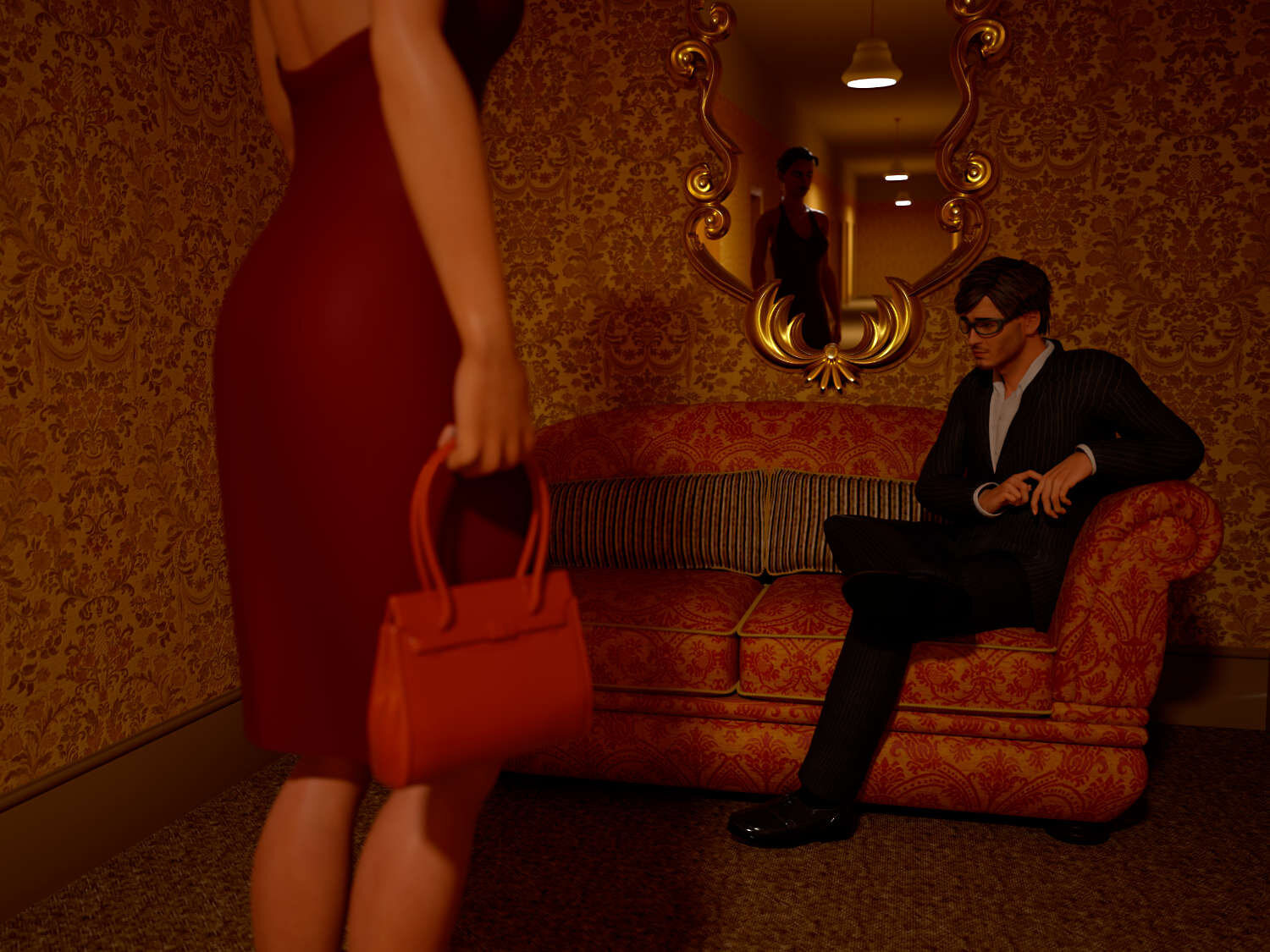
Last Year at Marienbad, Digital Print on Aluminium, Edition 5, 60 x 90 cm, $3,500. familiarity stemming from my student years when I was educating myself about the art forms that a visual artist has a natural affinity for, such as cinema. That familiarity came from still images illustrating articles written by film critics who reverently analysed Alain Resnais' famous film, Last Year in Marienbad, describing how it told its story visually. Because those images reproduced so well in print they have stayed with me despite the naysayers who have judged the film as baffling and pretentious. The most often reproduced images from the film feature the splendid formal gardens with the dramatically topiarised conical shrubbery bordering the broad paths leading to the eponymous hotel where the story of an encounter between a man and a woman takes place. Those outdoor images have a dreamlike timeless quality but in making this interpretation I opted for an interior scene where the woman, who can barely be identified by the shadowy reflection in an ornate gilt mirror, approaches the man whose reaction is ambivalent. I chose this setting because of hotels I have stayed in which inevitably feature the banal geometry of long corridors, here seen framed by the mirror.
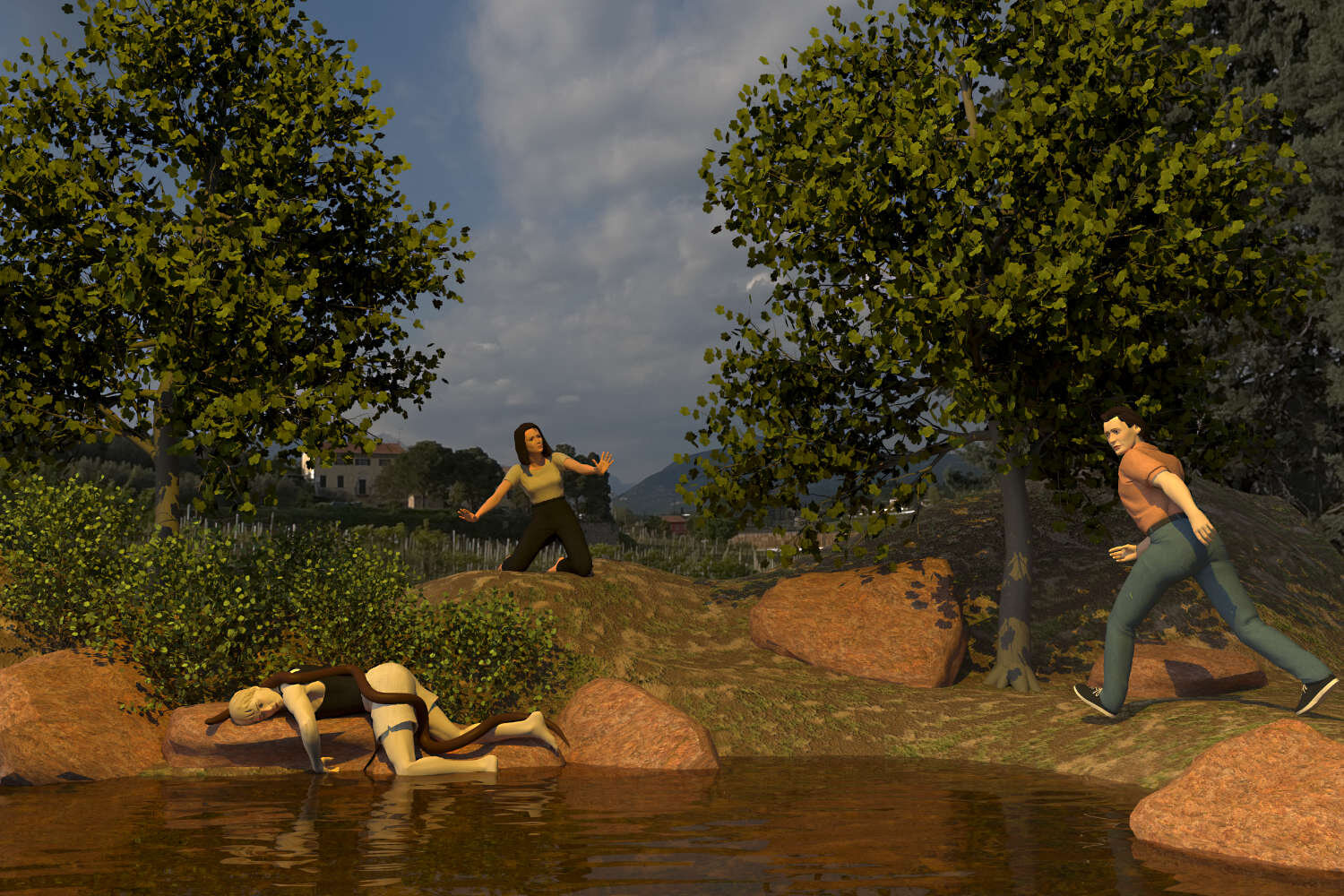
Landscape With a Man Killed By a Snake, Digital Print on Aluminium, Edition 5, 60 x 90 cm, $3,500. A viewer of Poussin's painting could easily be seduced by the bucolic loveliness of the landscape and overlook the fatal drama which has taken place there. The figures are barely discernable in the forest, but look closely and the cry of their alarm is palpable. My rendition of Poussin's Landscape With a Man Killed By a Snake is more akin to Hollywood, it has a theatricality which undermines the sense of tragedy. The intention was not to satirise Poussin's work, which I admire, it was more about testing the boundaries of this project reimagining classic art and cinema. I would definitely have treated the subject with more delicacy and sombreness had I made it a few years later.
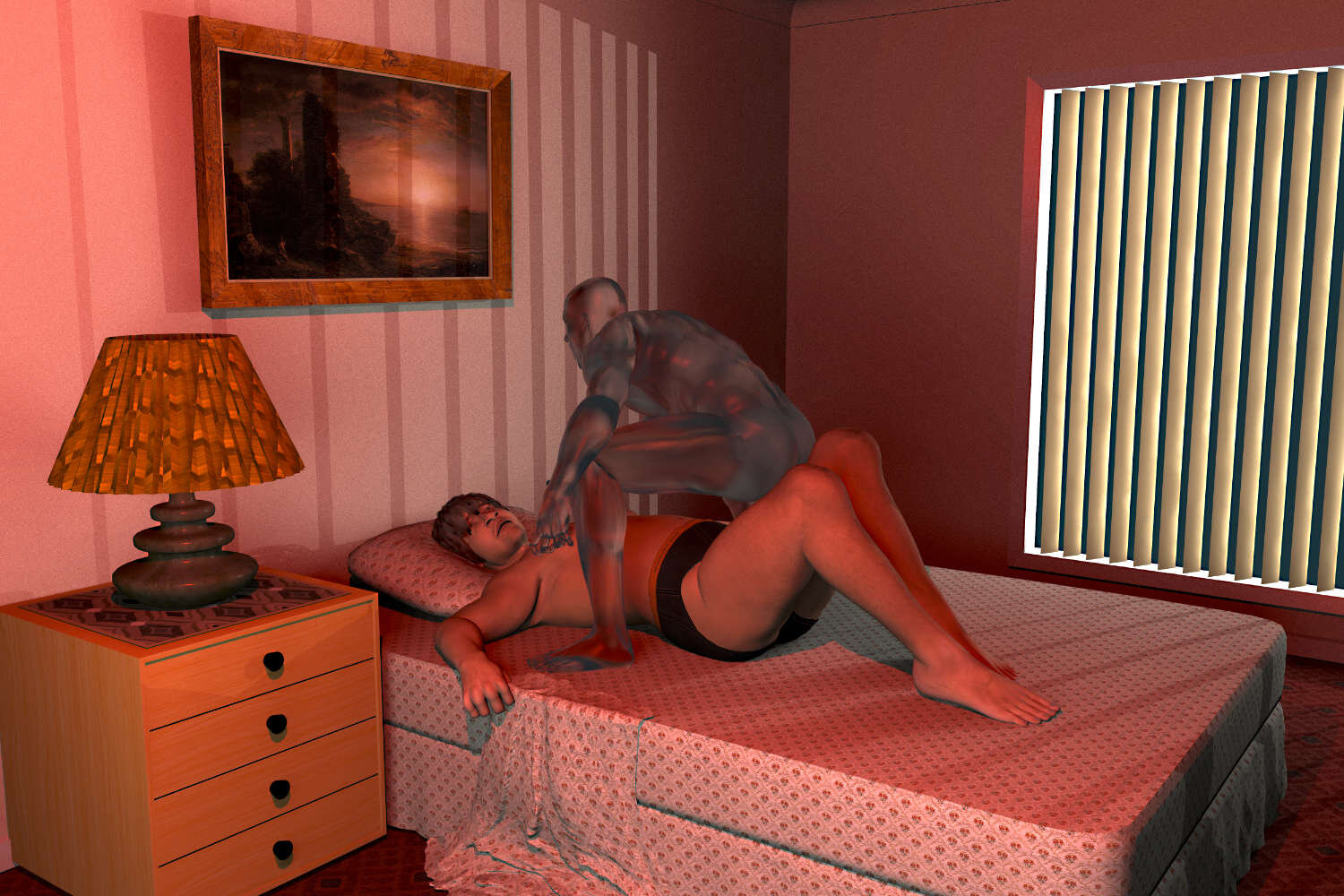
The Horla, Digital Print on Aluminium, Edition 5, 60 x 90 cm, $3,500. The Horla is a classic horror short story about demonic possession written by the French writer, Guy de Maupassant, in 1887. It describes a comfortable bourgeois gentleman's descent into madness after he realises his malaise is caused by an sinister invisible incubus who visits him at night. This scenario is a staple of horror cinema which I wished to avoid. The solution was to go with an offbeat homo-erotic approach where an overweight man sleeping in a cheap motel room is straddled by a muscular glassy demon. The Maupassant character has a psychological strength which he used to combat the parasitic creature but I decided to portray a man who would probably succumb and who could also be uncharitably viewed as a loser by our competitive society.
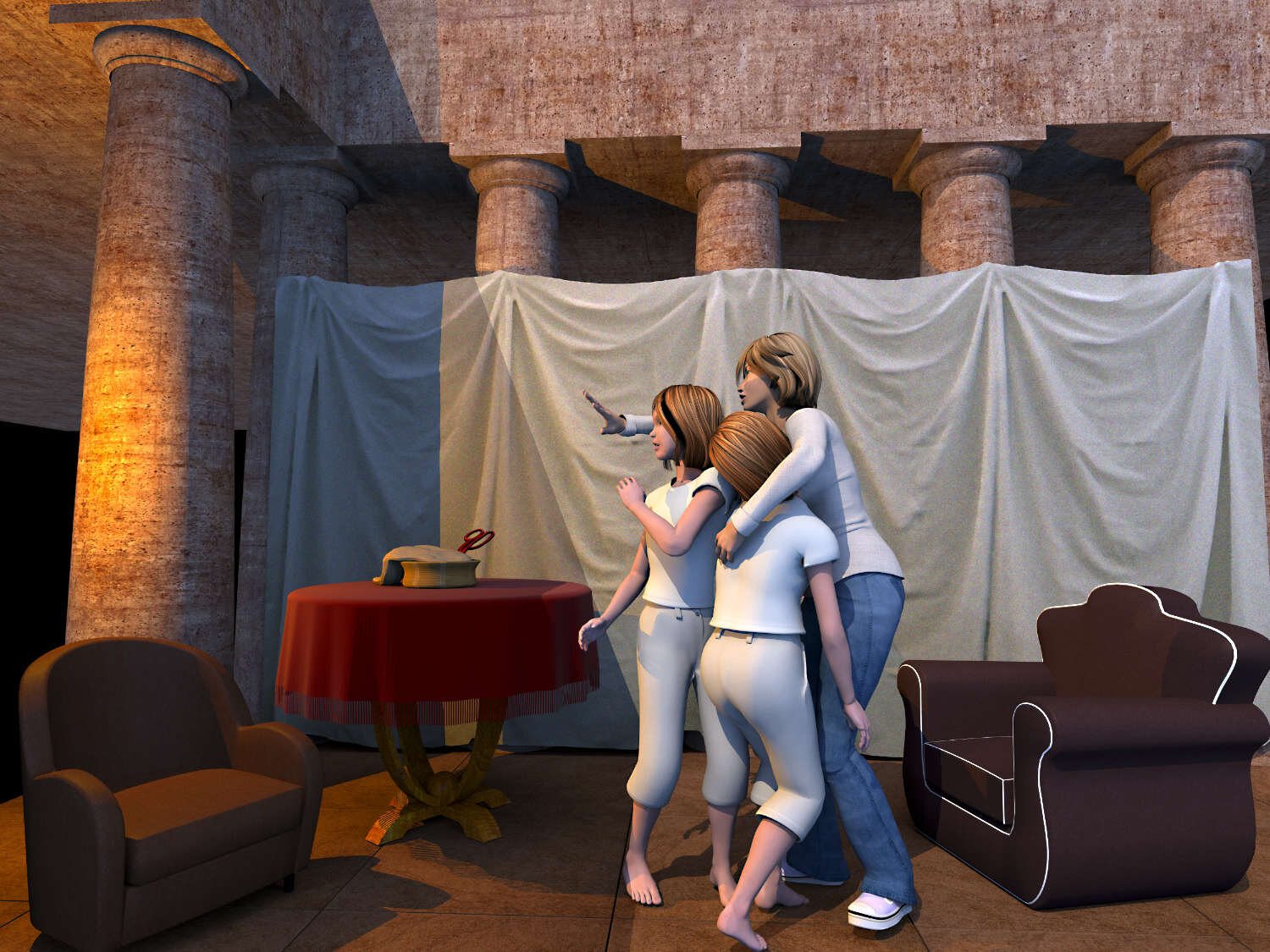
The Lictors Bring to Brutus The Bodies of His Sons. $3,500 Jacques-Louis David had a gift of creating visual art that served the goals of the French Revolution in the late eighteenth century. Although his cool Neo-classical style doesn't make for cosy art it certainly has an impressive formal power and it generally avoided crude political hyperbole. His painting, The Lictors Bring to Brutus The Bodies of His Sons, moralises about the virtues of upholding the ideals of the state even when it codemned Brutus' sons to death for treason. It's a solemn art work that exposes the horror and grief experienced by his family and it's the section of this epic canvas detailing the reaction of his wife and daughters which I chose to focus on for this reimagining. The result is an odd mishmash of elements partially faithful to the David painting such as the background of heavy Roman columns, 1940s furniture which I thought most closely resembled David's notion of Roman interior style and the trio dressed in clothes fashionable twenty years ago. The sheet strung up on the columns presented a mild technical challenge which I solved by photographing some bed linen hung from the back verandah of my house and saved for use as a texture map.

The Valley, Digital Print on Aluminium, Edition 5, 60 x 90 cm, $3,500. I am a big fan of late twentieth century American photography, photographers such as Garry Winogrand, Lee Friedlander, William Eggleston and Stephen Shore are names synonymous with the documentation of quintessentially American lifestyles and landscapes. In 2004 a less well known photographer working in a similar idiom, Larry Sultan, published a fascinating photographic essay about the porn industry in California's San Fernando Valley simply called The Valley. It documents the industry's workers in suburban homes rented temporarily as sets for staging porn shoots and the viewer quickly realises that these people treat the work like any other job. We see actors pausing for a cigarette break and technicians taking a quick nap between takes, all taking place in humdrum suburban settings. Prior to this reimagining I had worked with material derived mainly from the classical visual arts and the documentary style of this photographic genre proved difficult to interpret. I gave up attempting to capture the spirit of this Larry Sultan photo and satisfied myself with this odd result whose meaning has become largely decoupled from the original. Ultimately it's an image of guy snoozing on the couch while another guy studies a couple having sex in a courtyard and it poses a lot of questions without even addressing the need to provide answers.

The Tempest, Digital Print on Aluminium, Edition 5, 60 x 90 cm, $3,500. During my high school art history classes I often wondered about the real meaning of some of the images in the textbook we were taught from. Our teacher had an unfortunate tendency to make art history dull while failing to intelligently discuss, for example, the Renaissance artist Giorgione's enigmatic 1506 painting The Tempest. In fairness, nobody has ever satisfactorily explained what the inexplicable iconography means but ultimately that is probably beside the point, it's the mad poetry which counts. At first glance, setting my interpretation of The Tempest in a suburban environment may seem to be a lazy effort in parsing its possiblities. It was not intended as casual cleverness, my high school years were spent in suburbia so there is some connection between those mind numbing school classes and the dull street my family lived in. The suburbs have long offered the promise of safety and predictability hence the vigilante in his camouflage t-shirt could be viewed as a metaphoric protector or more darkly, a harbinger of an uncertain future.

The Ambassadors, Digital Print on Aluminium, Edition 5, 60 x 90 cm, $3,500. The Ambassadors, Hans Holbein's exquisite 1533 portrait of a couple of powerful men captures the political and intellectual world these men inhabit. The backgound features a rich green patterned material and the shelf the men lean against hold the objects that defined the scientific and artistic knowledge of Europe at the time. These men haven't stinted on expensive clothes either, satin cloth and fur exude a quality that only the most powerful could afford. The men in this reimagining downplay their wealth, much like technocrats such as Mark Zuckerberg with his uniform of a colourless t-shirt these guys like to appear casual. Their clothes mask a reality of concentrated power, a flat screen TV on the wall plays news footage of U.S. president Donald Trump at an international conference, the iMac computer shows the Facebook login page, on the table is a high-end digital camera and a copy of Wired magazine has a cover story about the optimistic new future of robotics and artificial intelligence. There is one constant however; the anamorphic skull sitting at the bottom of the composition is there to remind us of our mortality and that material wealth is ultimately meaningless when we are dust.
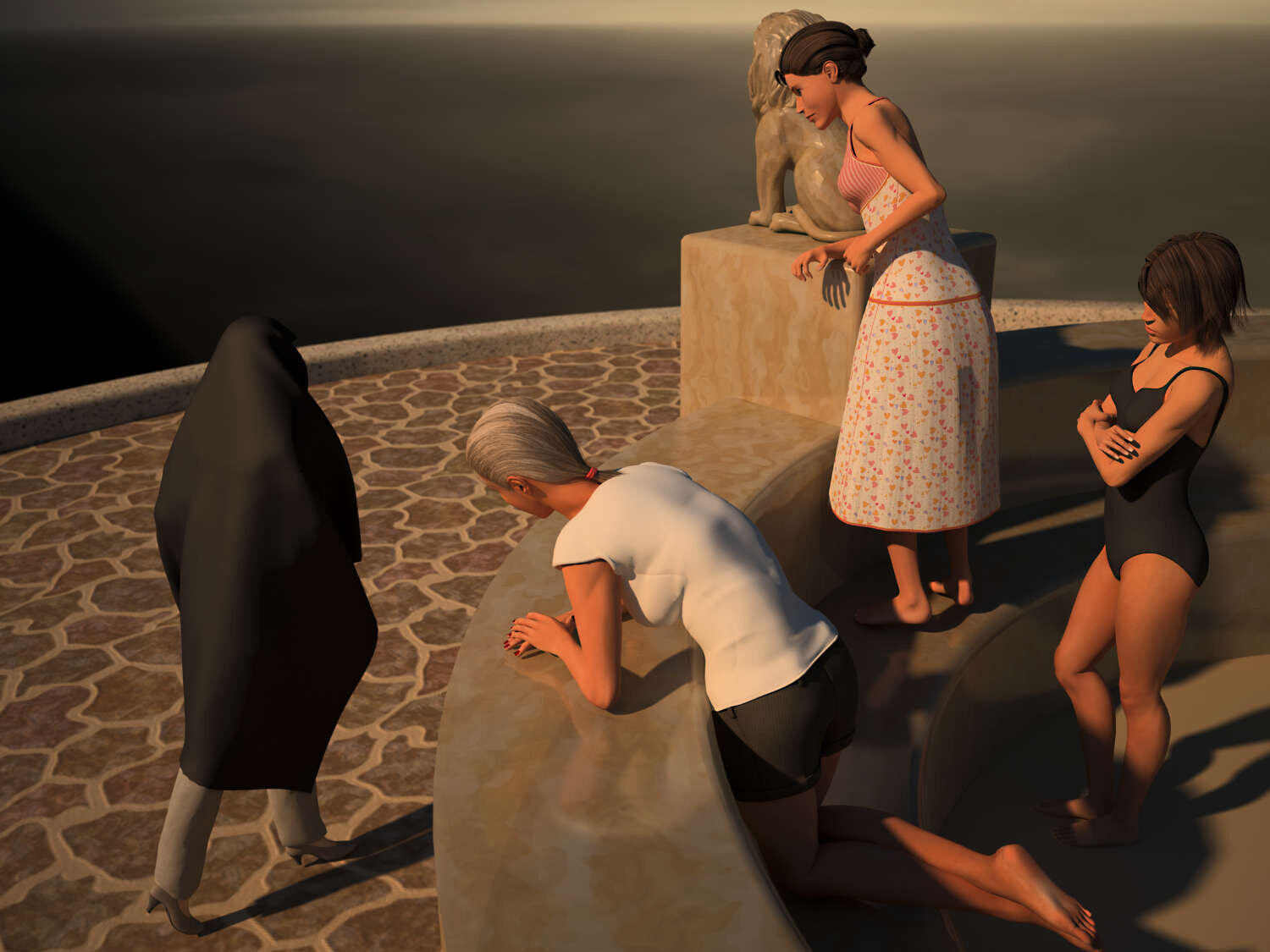
A Coign of Vantage, Digital Print on Aluminium, Edition 5, 60 x 90 cm, $3,500. Lawrence Alma-Tadema built a very successful artistic career on a conceit. The stock in trade of this Dutch born British Victorian artist was the depiction of languid young women hanging around opulent mock Greco-Roman marble buildings. Wealthy Victorians were prepared to pay considerable sums for this art cloaked in the pretense of history painting which generally legitimised the excuse for men to enjoy the spectacle of scantily clad women. A Coign of Vantage is a modest Alma-Tadema affair showing a group of women languorously gazing from an elevated perch at an arriving vessel. For this reimagining I kept the element I liked the most - the group of women - and substituted his background with a mysterious black clad female figure who was inserted to overcome a problem; the project had started to feel vacuous and it required a circuit breaker. The most interesting consequence of this decision is how an image intended for the gaze of Victorian men has been redirected into the realm of contemporary religious debate about female modesty and conclude the shrouded woman wears a burqua, although it should be noted austere black dress also symbolises mourning. Whatever the case might be, close inspection reveals that she likes to indulge in feminine items - she is wearing fashionable trousers and shoes - a practice among Saudi women who seek to enjoy femininity without annoying the morality police.

Agony in the Garden, Digital Print on Aluminium, Edition 5, 60 x 90 cm, $3,500. Throughout the history of western art, The Agony in the Garden, the event where Christ pondered his fate and his betrayal by Judas has been covered by many artists. The rich cast of characters in a dramatic setting has provided artists with a lot of material for interpretation and I'll go through the choices I made for my update on the subject. The first decision I made for this reimagining was deciding how the scene should be lit. The event has a sombre fatalistic tone, hence the ambient nocturnal gloom broken by an unearthly light emanating from the hovering angel. It serves to highlight Jesus and the disciples in their white tee shirts and endow the Romans emerging from the shadows in their dark clothes with a sense of menace. I don't know if there's a theological reason why Renaissance artists traditionally favoured naked cherubs for the representation of the angel but nowadays this would be a problematic choice. Portraying the angel as a naked female figure would also meet with disapproval in some quarters and those objecters aren't necessarily devout Christians. Some scholars believe that angels came in a cryptoid form which would've been a fascinating exploration if I had been aware of that research at the time. I decided to dress Jesus and the disciples uniformly for several reasons. Compositional simplicity is the main reason that also had the benefit of saving a lot of work because it required only one figure which was copied and configured into various poses. It's also worth noting that research into early Christianity led to some bible scholars to conclude it had a cult like organisation and this chimes nicely with the uniformity of this group of figures. It would have made sense to portray the Romans as military figures and this would have presented a narrative logic and well as a compositional logic. Instead I opted for a biker/goon squad depiction because such groups have a psychological creepiness plus their presence raises the philosophic questions about the legitimacy and coercive power of the state.
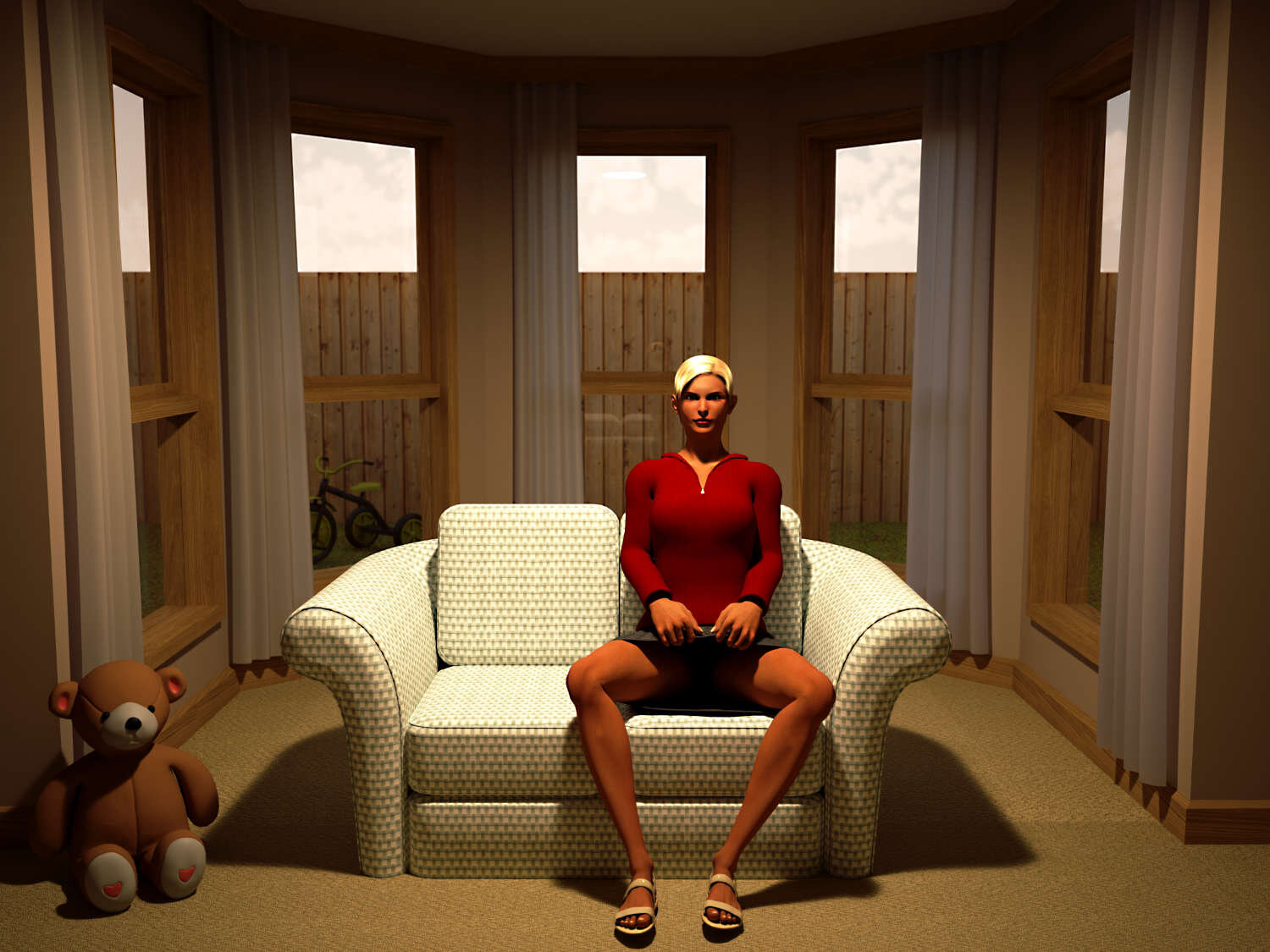
Sex Tape, Digital Print on Aluminium, Edition 5, 60 x 90 cm, $3,500. After reimagining mainly images of the past, Sex Tape is the first of this series that explores a contemporary theme. Access to fast internet bandwidth and inexpensive easy to use video cameras has led to the growth of do-it-yourself porn posted online. Exploring such salacious material presents a problem if the finished work is to be exhibited in a mainstream gallery. Consequently I chose the moment when this woman is about to expose herself to her audience using the lighting to conceal what our imagination knows what is about to unfold. My research into this topic revealed a variety of body types which makes this type of erotica more interesting than the standard maufactured porn and when I commenced this project I chose to allow for a degree of randomness in the software settings used to produce this figure. It resulted in her lean muscularity and severely clipped blonde hair and I opted to dress her in casual clothes as if her decision was an impromptu interruption to a routine day. The image reveals aspects about this woman's life, that she is most likely a mother is suggested by the soft toy propped up beside the couch and the tricycle in the backyard. A viewer could also assume that boredom with her circumstances might offer a reason why this woman is about to break the rules of propriety. The house is dull and suburban, the room is decorated in insipid tones of beige with a picture window overlooking a cramped yard and a paling fence blocking her view of the world.

David and Jonathan, Digital Print on Aluminium, Edition 5, 60 x 90 cm, $3,500. In 2014, when the news filtered out from the Syrian civil war about the terrorist group Islamic State's use of beheading videos as a tactic of fear I began to wonder about the durability of this ancient barbaric practice. These atrocities were clearly designed to capture the media's attention and instill dread into the comfortable citizens of the western nations. The message was also crafted to appeal to an aggrieved youth whose cultural diet of violent video games and gangsta rap music made them receptive to the revolutionary creed offered by I.S. The biblical tale of the vanquishing of the giant Goliath at the hands of David, a youth sent to take him out with the humblest of weapons, the slingshot, seemed an appropriate metaphor of the Islamic State's optomistic but ultimately ill-fated agenda. Beheading is a gruesome act which I have no appetite for, so I chose to reimagine its aftermath depicted by Giovanni Battista Cima da Conegliano in his painting of David carrying his trophy of Goliath's head whilst casually wandering the countryside accompanied by his friend Jonathan. I dressed the youths in street gear popular at the time; baseball cap, hoodie, track pants and sneakers, unmindful that this clothing was popular with the disaffected youth Islamic State had attracted from the west as recruits, that information was reported some months later. The jacket and sneaker strewn on the ground is a detail from news reports about the terrified fleeing Iraqi army discarding any evidence of their complicity with the government. The background features mcmansions typical of Australian suburbia of the last few decades, they are included as a symbol of peace and stabilty a universe away from the turmoil in Syria but they also spawned some of Islamic State's recruits.
